Brazil
Seitenübersicht
[Ausblenden]This wiki contribution is dealing with Brazil's state response to the ongoing global pandemic of the Coronavirus Disease 2019 (COVID-19). COVID-19 is caused by the Severe Acute Respiratory Syndrome Coronavirus 2 (SARS-CoV-2), a novel coronavirus which has previously not been identified in humans. Initially, it was reported in Wuhan, China in mid-December 2019. Followed by international spread, it was declared a pandemic by the UN's World Health Organisation on March 11th. Brazil's (plus South America's) first case was reported on February 26th when a 61-year old man returning from Lombardy, Italy, was diagnosed positively to the virus. The COVID-19 pandemic is exposing Brazil to an unprecedented challenge. In March numbers skyrocketed, turning Brazil into one of the worst affected countries in the world, a global epicentre of the outbreak and the hardest-hit country in South America. Moreover, Brazil is the second most exposed country globally in numbers of confirmed cases and deaths. Having hit the 1 million case mark on June 19th, 2020, some even predict that Brazil could pass the US leading the highest caseload by August 2020 [1] [2] .
Besides this tremendous public health crisis, Brazil finds itself in far-reaching political insecurities, wherein the Brazilian government's highly ineffective and uncoordinated management of the COVID-19 pandemic has played a major role. The crisis displays itself in a highly polarized population and includes numerous disputes within the federal government and between federal and state governments about the strategy pursued in dealing with the disease as well as conflicts in the horizontal distribution of power between the branches of government. Brazil's president Jair Bolsonaro (65), who repeatedly trivialized the threat of the virus by declaring it a "small flu" and attending public anti-lockdown rallies, often without the wearing of a mask and the implementation of social distancing measures, was diagnosed positively for COVID-19 on Tuesday, 7th of July.
To assess Brazil's pandemic response, this Wiki analysis utilizes Boin et al.'s (2017) framework of "five critical tasks of strategic crisis leadership" [3] , namely sense making, decision making and coordinating, meaning making, accounting and learning as structural underpinnings for the analysis.
So far, the spread of the virus has not slowed down and the country is expected to slide yet into another recession. Because the task ends on July 14th, all events and developments beyond this date are regarded as irrelevant to the Wiki.
Besides this tremendous public health crisis, Brazil finds itself in far-reaching political insecurities, wherein the Brazilian government's highly ineffective and uncoordinated management of the COVID-19 pandemic has played a major role. The crisis displays itself in a highly polarized population and includes numerous disputes within the federal government and between federal and state governments about the strategy pursued in dealing with the disease as well as conflicts in the horizontal distribution of power between the branches of government. Brazil's president Jair Bolsonaro (65), who repeatedly trivialized the threat of the virus by declaring it a "small flu" and attending public anti-lockdown rallies, often without the wearing of a mask and the implementation of social distancing measures, was diagnosed positively for COVID-19 on Tuesday, 7th of July.
To assess Brazil's pandemic response, this Wiki analysis utilizes Boin et al.'s (2017) framework of "five critical tasks of strategic crisis leadership" [3] , namely sense making, decision making and coordinating, meaning making, accounting and learning as structural underpinnings for the analysis.
So far, the spread of the virus has not slowed down and the country is expected to slide yet into another recession. Because the task ends on July 14th, all events and developments beyond this date are regarded as irrelevant to the Wiki.
1 Introduction
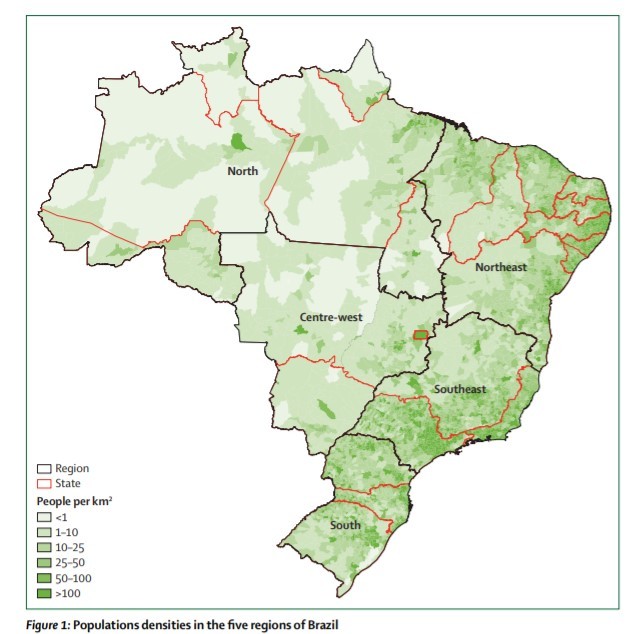
Figure 1; Brazil's regions and population density
Brazil (officially Federative Republic of Brazil or República Federativa do Brasil) is a country located in South America. It covers the continent’s half landmass and is the fifth largest country in the world by size [4] . Brazil shares borders with eight South American countries, precisely Uruguay, Argentina, Paraguay, Bolivia, Colombia, Venezuela, Guyana, Suriname and French Guyana. Its estimated population is 209, 712, 000 mio. (2019) ranking it the 6th most populous in 2018 and by far the most populous in South America [5] . The population is predominantly urban with Brazilians living in urban areas making off 86.6% relative to the total population and São Paulo being the most populated city in Brazil. Followed by Rio de Janeiro and Salvador, larger cities concentrate mostly along the eastern coastline (see Figure 1). Introduced by Portuguese colonialization, Portuguese is the Brazil's official language [6] .
Brazil's society is composed very heterogeneously as the country became a "melting pot" for a wide range of cultures during the centuries [cf. 1]. Major ethnic groups are Brazilians of European descent (or "white") (47.7%), mullattoes (mixed white and black) and mestizios (mixed European and Indian ancestry) (43.1%), there is a small amount of entirely African, Afro-Indian and Asian populations. Indians are the smallest ethnic group [7] . Uneven patterns of land ownership and extreme social inequalities remain major issues of the country in the 21st century [cf. 3]. Income inequality and poverty disproportionately affect the Northeast, North, and Center-West regions as well as women, the black, mixed-race, and indigenous populations. Brazil has relatively young demographics as the highest proportion of the population is between 15-54 years and about 9.2% are above 65 [cf. 6]. Furthermore, Brazil has a median age of 33.5 years which is considerably younger then especially East Asian and Western European G20 states averages [8] .
In the Human Development Index, which measures countries' progress and basic human development in three dimensions (long and healthy life, access to knowledge, decent standard of living) using several distinct indicators, Brazil positions 79 out of 189 countries and territories, trending positively since 1990 [9] . Even though referred to as a rapidly growing economic power and a state of the Bric-group (emerging economies with fast growth rates) in the first decade of the 21st century, Brazil went through a strong recession in the years 2015 and 2016 [10] . The economic recovery has been sluggish and economic growth in 2017 and 2018 did not exceed more than 1.1% a year, compared to 6.07% in 2007 [see World Bank Development Indicators]. In addition, Brazils' economy was negatively affected by numerous corruption scandals and public debt is among the highest in any emerging economy [11] . In terms of GDP per capita, Brazil in 2018 stands below the regional average with states such as Chile, Uruguay, Argentina, and Mexico outpassing it [see World Bank].
Brazil's society is composed very heterogeneously as the country became a "melting pot" for a wide range of cultures during the centuries [cf. 1]. Major ethnic groups are Brazilians of European descent (or "white") (47.7%), mullattoes (mixed white and black) and mestizios (mixed European and Indian ancestry) (43.1%), there is a small amount of entirely African, Afro-Indian and Asian populations. Indians are the smallest ethnic group [7] . Uneven patterns of land ownership and extreme social inequalities remain major issues of the country in the 21st century [cf. 3]. Income inequality and poverty disproportionately affect the Northeast, North, and Center-West regions as well as women, the black, mixed-race, and indigenous populations. Brazil has relatively young demographics as the highest proportion of the population is between 15-54 years and about 9.2% are above 65 [cf. 6]. Furthermore, Brazil has a median age of 33.5 years which is considerably younger then especially East Asian and Western European G20 states averages [8] .
In the Human Development Index, which measures countries' progress and basic human development in three dimensions (long and healthy life, access to knowledge, decent standard of living) using several distinct indicators, Brazil positions 79 out of 189 countries and territories, trending positively since 1990 [9] . Even though referred to as a rapidly growing economic power and a state of the Bric-group (emerging economies with fast growth rates) in the first decade of the 21st century, Brazil went through a strong recession in the years 2015 and 2016 [10] . The economic recovery has been sluggish and economic growth in 2017 and 2018 did not exceed more than 1.1% a year, compared to 6.07% in 2007 [see World Bank Development Indicators]. In addition, Brazils' economy was negatively affected by numerous corruption scandals and public debt is among the highest in any emerging economy [11] . In terms of GDP per capita, Brazil in 2018 stands below the regional average with states such as Chile, Uruguay, Argentina, and Mexico outpassing it [see World Bank].
1.1 The Political System of Brazil
Since the countries' coronacrisis response is accompanied by multiple political events with considerable significance and as there are voices claiming "the pandemic turned political in Brazil" [12], this section serves readers to gain a preliminary and rudimentary understanding of the Brazilian polity.
Brazil is a federal presidential republic, divided into 26 federal states plus the federal district including the capital city of Brasília. Its current constitution stems from 1988. The federal states are semi-autonomous entities, having their own constitutions, justice systems, directly elected governors and legislative assemblies. They are further subdivided into numerous municipalities. The bicameral National Congress (Congresso Nacional) represents the legislative branch of Brazils’ political system, consisting of the Chamber of Deputies (Câmara dos Deputados) and the Federal Senate (Senato Federal). While deputies are elected to the Chamber every four years, senators have an eight-year term of office to serve. Universal suffrage is exercised voluntarily between 16-18 years of age and compulsory between 18 and 70. Executive power is mainly exercised by the head of State and Government, which is President Jair Bolsonaro since 2019. The President is directly elected, serves a term of four years, and is eligible for one additional term. The president has a share of wide powers, including the appointing of ministers of state and several other heads of ministerial-level departments [13]. Under the 1988 constitution, "reactive" powers of the president involve a veto to legislation, which can be overridden by congress through an absolute majority and strong control over the budget. "Proactive" powers refer to Article 62, enabling presidents to implement "Provisional Measures" without congressional approval, "that have the force of law for a thirty-day period". Article 62 was explicitly designed for cases of "relevance and urgency", Mainwaring (1997) stresses, however, that "presidents have used Provisional Measures to push through all kinds of bills, with little concern for whether they truly constitute emergencies". In the same manner, presidents have considerable capacities to shape the congressional agenda: "if Congress fails to act on a presidential decree within 30 days, the Provisional Measure automatically goes to the top of the legislative agenda, displacing issues that the congress may have been discussing for some time" [14].
The judicial system comprises two branches: The ordinary branch, consisting of State and federal courts and a special branch with labour, electoral and military courts. The Supreme Federal Court (Supremo Tribunal Federal) is Brazil’s highest courts. It provides “final rulings on constitutional issues and hears cases involving the president, the vice president, Congress, the judiciary, the attorney general, government ministers, diplomats, foreign countries, and the political or administrative divisions of the union” [see Britannica].
Brazil is a federal presidential republic, divided into 26 federal states plus the federal district including the capital city of Brasília. Its current constitution stems from 1988. The federal states are semi-autonomous entities, having their own constitutions, justice systems, directly elected governors and legislative assemblies. They are further subdivided into numerous municipalities. The bicameral National Congress (Congresso Nacional) represents the legislative branch of Brazils’ political system, consisting of the Chamber of Deputies (Câmara dos Deputados) and the Federal Senate (Senato Federal). While deputies are elected to the Chamber every four years, senators have an eight-year term of office to serve. Universal suffrage is exercised voluntarily between 16-18 years of age and compulsory between 18 and 70. Executive power is mainly exercised by the head of State and Government, which is President Jair Bolsonaro since 2019. The President is directly elected, serves a term of four years, and is eligible for one additional term. The president has a share of wide powers, including the appointing of ministers of state and several other heads of ministerial-level departments [13]. Under the 1988 constitution, "reactive" powers of the president involve a veto to legislation, which can be overridden by congress through an absolute majority and strong control over the budget. "Proactive" powers refer to Article 62, enabling presidents to implement "Provisional Measures" without congressional approval, "that have the force of law for a thirty-day period". Article 62 was explicitly designed for cases of "relevance and urgency", Mainwaring (1997) stresses, however, that "presidents have used Provisional Measures to push through all kinds of bills, with little concern for whether they truly constitute emergencies". In the same manner, presidents have considerable capacities to shape the congressional agenda: "if Congress fails to act on a presidential decree within 30 days, the Provisional Measure automatically goes to the top of the legislative agenda, displacing issues that the congress may have been discussing for some time" [14].
The judicial system comprises two branches: The ordinary branch, consisting of State and federal courts and a special branch with labour, electoral and military courts. The Supreme Federal Court (Supremo Tribunal Federal) is Brazil’s highest courts. It provides “final rulings on constitutional issues and hears cases involving the president, the vice president, Congress, the judiciary, the attorney general, government ministers, diplomats, foreign countries, and the political or administrative divisions of the union” [see Britannica].
1.2 Political Situation prior to COVID-19
The COVID-19 pandemic hit Brazil amid the presidency of Jair Bolsonaro, who is portrayed as a far-right populist. Bolsonaro was elected president in the second round in October 2018 and took office on 1st January 2020. A self-claimed homophobe [12] and called a misogynist and racist by his opponents, Bolsonaro has regularly expressed his admiration and nostalgia for brazil's military dictatorship (1964-1985) (ibid.). Named "Trump of the tropics", Bolsonaro, a climate sceptic, is a deeply polarizing figure. He won the presidential election during heavy unemployment and after former president, Lula da Silva, was charged with corruption. Bolsonaro's predecessor Dilma Rousseff was impeached from office in 2016. Bolsonaro's power base is mostly seen in the evangelicals [13] and the military, with a considerable part of his cabinet consisting of former or on-duty military men [14] .
As a result of no clear political majorities for him in congress, leading to disputes between the legislative and executive branches, Brazil experiences both political stagnation and instability [15] . In economic terms, Brazil faced small GDP growth in 2019 fueling hopes that the country was about to leave its long-ranging previous recession [16] .
As a result of no clear political majorities for him in congress, leading to disputes between the legislative and executive branches, Brazil experiences both political stagnation and instability [15] . In economic terms, Brazil faced small GDP growth in 2019 fueling hopes that the country was about to leave its long-ranging previous recession [16] .
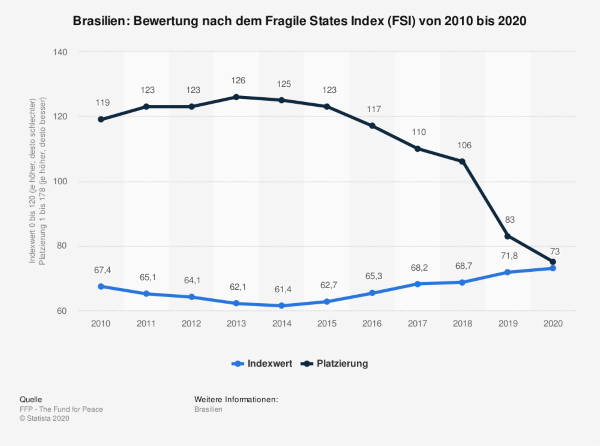
Figure 2, Brazil after the Fragile States Index
According to the Fragile States Index (previously Failed States Index, Figure 2) which measures countries' stability, Brazil has a value of 73 points [17] putting the country in the category of "Elevated Warning" regarding its vulnerability to conflict or collapse. It can be observed, that Brazil's negative trend since 2015 runs parallel to its economic development. As multiple nations develop negatively in the index, Brazil's downfall in terms of performance is not matched with a downfall in placement.
Meeting its nationally uncoordinated and diverging approach between federal and state-level governments of combatting COVID-19, the WHO lists Brazil under the category of no "National Plan for Pandemic Preparedness and Risk Management" that is publicly available in case of an virus outbreak [18] . Against this finding, the GHS index lists an "Epidemiological Surveillance Plan" for Brazil which establishes common procedures in case of pandemic diseases, such as influenza, cholera, or dengue and further plans for individual diseases [19] . However, there is absolutely no evidence whatsoever, that this plan was put into place or utilized for the COVID-19 pandemic. Brazil therefore highly contrasts from countries that followed precise epidemiological guidelines and scientific approaches in dealing with the new pandemic like Taiwan (https://ilias.uni-konstanz.de/ilias/goto.php?client_id=ilias_uni&target=wiki_1008389_Taiwan#ilPageTocA19 or South Korea https://ilias.uni-konstanz.de/ilias/goto.php?target=wiki_1008389_South_Korea].
I try to look at "Preparedness" from an angle of particular and unique preconditions to COVID-19 in Brazil. Thereby, aspects such as the healthcare system, GHS index, COVID-19 Regional Safety Assessment by Deep Knowledge Groupe, and political factors are regarded.
Above all other factors turning the novel coronavirus to a major global health challenge, such as little scientific knowledge, the fast pace of its spread, and its capacity to cause deaths in vulnerable groups the spread of COVID-19 in Brazil takes place in a context of huge social inequality. Precarious housing without access to running water and with widespread crowding fuels the disease's pace of transmission [20] . The circumstances for the adoption of different strategies of social distancing and its effects are therefore stated to be limited for Brazil (ibid.).
I try to look at "Preparedness" from an angle of particular and unique preconditions to COVID-19 in Brazil. Thereby, aspects such as the healthcare system, GHS index, COVID-19 Regional Safety Assessment by Deep Knowledge Groupe, and political factors are regarded.
Above all other factors turning the novel coronavirus to a major global health challenge, such as little scientific knowledge, the fast pace of its spread, and its capacity to cause deaths in vulnerable groups the spread of COVID-19 in Brazil takes place in a context of huge social inequality. Precarious housing without access to running water and with widespread crowding fuels the disease's pace of transmission [20] . The circumstances for the adoption of different strategies of social distancing and its effects are therefore stated to be limited for Brazil (ibid.).
1.3 Preconditions of the "Brazilian Case"
Shortly after the identification of the first case on Brazilian soil and before mass spreading of COVID-19 took place, scholars characterized the Brazilian healthcare system as "already fragile and vulnerable" and not sufficiently prepared for enduring a global pandemic. The social and economic issues in South America affecting the Health System previously were stressed, such as the political crisis in Venezuela causing migration linked to infectious diseases (for instance malaria) as further challenges. Concern was also raised about the adequate availability of intensive care units (ICU) and the availability of specific diagnosis tests (particularly the real-time PT-PCR) as crucial means for the detection of COVID-19 and the prevention of onward transmission. As the continent already suffers from dengue and measles, an epidemiological scenario called a "syndemic", that is the aggregation of two or more epidemics in a population, was named likely [21] .
Further factors exacerbate the Brazilian preconditions in case of a pandemic: Brazilian social heterogeneity raises the need for different medical and social management in each area. There is, due to the diversity of ethnicities and ancestral backgrounds, a high variability at the genome level, meaning that subpopulations share diverging genetic features. In this context, little is known about how genetic diversity leads to different phenotypic responses to COVID-19. Concerns were also raised about the indigenous population (ca. 500.000) as they have limited access to hospitals for intubation. This restriction of medical care, in particular, could lead to devastating outcomes for this part of the population.
Challenges profoundly involve housing as well, as it is crucial for the success of quarantine measures: The "great urban low-income conglomerates" [22] known as "Favelas" provide precarious living conditions with no or limited access to health, social, and financial support. Therefore "the infection can be transmitted and without diagnostic confirmation before or after death" in the Favelas. As people live closely together and share limited living space social distancing measures are almost impossible to adopt.
Another "Brazilian" challenge is the limited financial resources in terms of performing COVID-19 diagnosis and resources to deal with the disease at university hospitals, as support to research and scholarship was just recently cut [23] . Another area of uncertainty is the behaviour of the virus in a tropical climate: "Maybe, like other countries, Brazil may have a different severity and/or disease progression". According to Marson and Ortega (2020), Brazil lacks formal data on ICU beds and sub intensive care beds. Beds are further distributed between the private and public health systems with the demand of patients needing the public health system to be considerably higher. Following their estimation the number read as follows: The number of ICU beds is estimated between 60,000~62,000, for the most part, concentrated in three states: Sao Paulo (~18,000), Rio de Janeiro (~7,000) and Minas Gerais (~6,000). The number of beds is though not equally distributed across the country at the time of the estimation there was an occupancy rate of ~90%. Brazil has approximately 1 bed for every 10,000 citizens (WHO recommends 1-3). The quantity of respirators is also scarce, as ca. 65,000 respirators were estimated.
Another urgent issue is created by the size of the informal sector. About 40% of the working population works without a regular employment contract, which is about 38 million people [24] . In the event of pandemic measures that bring down public life, this part of the population is left without any income security or social protection. As these people depend on their day to day earnings shutdown measures affecting the economy would present a significant threat of imposing them to poverty and hunger.
Further factors exacerbate the Brazilian preconditions in case of a pandemic: Brazilian social heterogeneity raises the need for different medical and social management in each area. There is, due to the diversity of ethnicities and ancestral backgrounds, a high variability at the genome level, meaning that subpopulations share diverging genetic features. In this context, little is known about how genetic diversity leads to different phenotypic responses to COVID-19. Concerns were also raised about the indigenous population (ca. 500.000) as they have limited access to hospitals for intubation. This restriction of medical care, in particular, could lead to devastating outcomes for this part of the population.
Challenges profoundly involve housing as well, as it is crucial for the success of quarantine measures: The "great urban low-income conglomerates" [22] known as "Favelas" provide precarious living conditions with no or limited access to health, social, and financial support. Therefore "the infection can be transmitted and without diagnostic confirmation before or after death" in the Favelas. As people live closely together and share limited living space social distancing measures are almost impossible to adopt.
Another "Brazilian" challenge is the limited financial resources in terms of performing COVID-19 diagnosis and resources to deal with the disease at university hospitals, as support to research and scholarship was just recently cut [23] . Another area of uncertainty is the behaviour of the virus in a tropical climate: "Maybe, like other countries, Brazil may have a different severity and/or disease progression". According to Marson and Ortega (2020), Brazil lacks formal data on ICU beds and sub intensive care beds. Beds are further distributed between the private and public health systems with the demand of patients needing the public health system to be considerably higher. Following their estimation the number read as follows: The number of ICU beds is estimated between 60,000~62,000, for the most part, concentrated in three states: Sao Paulo (~18,000), Rio de Janeiro (~7,000) and Minas Gerais (~6,000). The number of beds is though not equally distributed across the country at the time of the estimation there was an occupancy rate of ~90%. Brazil has approximately 1 bed for every 10,000 citizens (WHO recommends 1-3). The quantity of respirators is also scarce, as ca. 65,000 respirators were estimated.
Another urgent issue is created by the size of the informal sector. About 40% of the working population works without a regular employment contract, which is about 38 million people [24] . In the event of pandemic measures that bring down public life, this part of the population is left without any income security or social protection. As these people depend on their day to day earnings shutdown measures affecting the economy would present a significant threat of imposing them to poverty and hunger.
1.4 Brazil's Healthcare System
The average life expectancy in Brazil in 2016 was 72.9 years for males and 79.4 years for females. After re-democratization, Brazil's 1988 constitution establishes health as a "fundamental right and responsibility of the state" [25] forming the basic principle of Brazil's health system. Brazils health system is forming a public-private mix and is subdivided into three parts: The public subsector (services provided and financed by the state at the federal, state and municipal levels), the private subsector (profit and non-profit), in which services are financed in various ways with public or private funds; and finally, the private health insurance subsector, based on different forms of health plans, varying insurance premiums and tax subsidies [26] . The health systems' public sector is organized around the Sistema Único de Saúde (SUS) and covers approximately 75% of the population (2011) [27] . Financing involves general taxes and social contributions collected by the three levels of government (federal, state, and municipal) (ibid.). The SUS provides health care through a decentralized network of clinics, hospitals, and other establishments. It aims to provide "comprehensive, universal preventive and curative care through decentralized management and provision of health services and promotes community participation at all administrative levels" and is free of charge. The public and private components of the system "are distinct and interconnected", people can use services in all three subsectors, mainly depending on their ability to pay. Therefore, public hospitals mainly serve poorer Brazilians and since the private sector is offering services on an out-of-pocket basis it is mostly used by the high-income population. Four-fifths of the hospitals in Brazil are public institutions and the largest share of doctors and hospitals concentrate in urban areas. This being, Brazil's widespread regional and social inequalities also show in the countries' health system as large disparities in health service coverage and access to healthcare persist.
Brazil's public health sector faces, in contrast to the private sector, numerous challenges such as low public funding due to austerity measures by the state and major deficits in equipment. In their 2018 paper "The Brazilian health system at crossroads: progress, crisis, and resilience" Massuda et al. find that "Economic recession and political crises pose a major threat to Universal Healthcare as well as long term austerity measures" as economic crises since 2014, accompanied by a sharp fall in GDP growth, lead to major cuts in health system financing, resulting in "inadequate financing" for public healthcare. Since 2015 there has been a reduction in the average per-capita funds allocated by municipalities to the UHS, "exacerbating historical underfunding and resource scarcity in the health system", and according to recent media reports leading to shortages of basic medicines, worsening working conditions for health professionals and shortages of doctors in public health facilities. They stressed further that Brazil has one of the lowest proportion of public spending on health (46.0%) in Latin America and the Caribbean (average 51.28%), in upper-middle-income countries (55.2%) and in OECD countries (62.2%). Several outbreaks of infectious diseases, such as yellow fever in 2016 and 18, the resurgence of syphilis, malaria, and dengue (with the highest recorded cases between 2016-18) and the emergence of new infectious diseases such as Chikungunya and Zika viruses have further put the Universal Healthcare System under pressure (cf .). Severe underfunding shows also in the number of hospital beds from 2010 to 2019 which has declined effectively from 2.28 beds per 1000 inhabitants to 1.95 in 2019 [28] .
Infectious diseases are a major public health issue for Brazil, despite the proportion of total deaths that are being caused decreasing tremendously [29] . The country is frequently hit by epidemics. In 2015 and 2016 the country found itself already in the epicentre of a large-scale virus outbreak, namely the Zika Virus, which was an epidemic of global concern. The mosquito-borne virus proved to have far-reaching consequences, especially for pregnant women, supposedly causing a serious birth defect in newborns known as microcephaly [30] . It was declared a "Public Health Emergency of International Concern (PHIC) by the WHO. The main outbreak of the virus occurred simultaneously to the Olympic and Paralympic Games in Brazil. In May 2017, the Brazilian government ended its public health emergency on Zika. In the Zika case, Brazil was able to organize a large-scale response. However, since the Zika spread is different from COVID-19 and it affects other groups the outbreak serves as a poor basis of comparison.
There were successes and failures in the control of infectious diseases in Brazil. Barretto et al. (2011) state that handling of cholera, Chagas disease, and those "preventable by vaccination" has proved successful "through efficient public policies and concerted efforts from different levels of government and civil society". In those cases of infectious diseases, policies that improved key determinants such as the quality of water and basic sanitation provided access to preventive resources (such as vaccines), and "successfully integrated health policies with broader social policies" were effective. In their study, the authors examine measures taken in past spreadings of infectious diseases and aim to identify policies to further improve control or interrupt transmission. They point out that in Brazil's ongoing process of rapid urbanization, "cash transfer programs for the neediest populations, the SUS, and other social and environmental improvements (such as in sanitation and education) are crucial for efforts to control infectious diseases" in Brazil. From this conclusion can be derived again how poor housing conditions found in the major cities of the country contribute to the risks of a pandemic. Speaking of epidemics, at the time of the writing, the health care system registered about 2.2 million dengue fever infections, the highest count in the region.
Brazil's public health sector faces, in contrast to the private sector, numerous challenges such as low public funding due to austerity measures by the state and major deficits in equipment. In their 2018 paper "The Brazilian health system at crossroads: progress, crisis, and resilience" Massuda et al. find that "Economic recession and political crises pose a major threat to Universal Healthcare as well as long term austerity measures" as economic crises since 2014, accompanied by a sharp fall in GDP growth, lead to major cuts in health system financing, resulting in "inadequate financing" for public healthcare. Since 2015 there has been a reduction in the average per-capita funds allocated by municipalities to the UHS, "exacerbating historical underfunding and resource scarcity in the health system", and according to recent media reports leading to shortages of basic medicines, worsening working conditions for health professionals and shortages of doctors in public health facilities. They stressed further that Brazil has one of the lowest proportion of public spending on health (46.0%) in Latin America and the Caribbean (average 51.28%), in upper-middle-income countries (55.2%) and in OECD countries (62.2%). Several outbreaks of infectious diseases, such as yellow fever in 2016 and 18, the resurgence of syphilis, malaria, and dengue (with the highest recorded cases between 2016-18) and the emergence of new infectious diseases such as Chikungunya and Zika viruses have further put the Universal Healthcare System under pressure (cf .). Severe underfunding shows also in the number of hospital beds from 2010 to 2019 which has declined effectively from 2.28 beds per 1000 inhabitants to 1.95 in 2019 [28] .
Infectious diseases are a major public health issue for Brazil, despite the proportion of total deaths that are being caused decreasing tremendously [29] . The country is frequently hit by epidemics. In 2015 and 2016 the country found itself already in the epicentre of a large-scale virus outbreak, namely the Zika Virus, which was an epidemic of global concern. The mosquito-borne virus proved to have far-reaching consequences, especially for pregnant women, supposedly causing a serious birth defect in newborns known as microcephaly [30] . It was declared a "Public Health Emergency of International Concern (PHIC) by the WHO. The main outbreak of the virus occurred simultaneously to the Olympic and Paralympic Games in Brazil. In May 2017, the Brazilian government ended its public health emergency on Zika. In the Zika case, Brazil was able to organize a large-scale response. However, since the Zika spread is different from COVID-19 and it affects other groups the outbreak serves as a poor basis of comparison.
There were successes and failures in the control of infectious diseases in Brazil. Barretto et al. (2011) state that handling of cholera, Chagas disease, and those "preventable by vaccination" has proved successful "through efficient public policies and concerted efforts from different levels of government and civil society". In those cases of infectious diseases, policies that improved key determinants such as the quality of water and basic sanitation provided access to preventive resources (such as vaccines), and "successfully integrated health policies with broader social policies" were effective. In their study, the authors examine measures taken in past spreadings of infectious diseases and aim to identify policies to further improve control or interrupt transmission. They point out that in Brazil's ongoing process of rapid urbanization, "cash transfer programs for the neediest populations, the SUS, and other social and environmental improvements (such as in sanitation and education) are crucial for efforts to control infectious diseases" in Brazil. From this conclusion can be derived again how poor housing conditions found in the major cities of the country contribute to the risks of a pandemic. Speaking of epidemics, at the time of the writing, the health care system registered about 2.2 million dengue fever infections, the highest count in the region.
Epidemiological legislation
Law no. 6.259, which was created before the unified health system (SUS), has been called the "main Brazilian standard for general epidemiological surveillance" [31] . Accordingly, the Brazilian Ministry of Health is responsible for coordinating and regulating measures to control diseases and health problems. The law provides for compulsory notification to health authorities of suspected or confirmed cases of diseases. Once notified, the health authority is obliged to carry out epidemiological investigations for instance on the spread of the disease) and to promptly adopt measures indicated for the control of the disease.
Brazil adopted the International Health Regulations, approved 2005 by the World Health Assembly. Therewith, Brazil assumed major international obligations in terms of health surveillance. 2011 the legal category of Public Health Emergency of National Importance was created. Two have been declared: the one related to Congenital Syndrome associated with infection by the Zika virus (CZS), between 2015 and 2017; and the one related to the new coronavirus (ibid.).
Law no. 6.259, which was created before the unified health system (SUS), has been called the "main Brazilian standard for general epidemiological surveillance" [31] . Accordingly, the Brazilian Ministry of Health is responsible for coordinating and regulating measures to control diseases and health problems. The law provides for compulsory notification to health authorities of suspected or confirmed cases of diseases. Once notified, the health authority is obliged to carry out epidemiological investigations for instance on the spread of the disease) and to promptly adopt measures indicated for the control of the disease.
Brazil adopted the International Health Regulations, approved 2005 by the World Health Assembly. Therewith, Brazil assumed major international obligations in terms of health surveillance. 2011 the legal category of Public Health Emergency of National Importance was created. Two have been declared: the one related to Congenital Syndrome associated with infection by the Zika virus (CZS), between 2015 and 2017; and the one related to the new coronavirus (ibid.).
1.5 Brazil's performance in the GHS Index
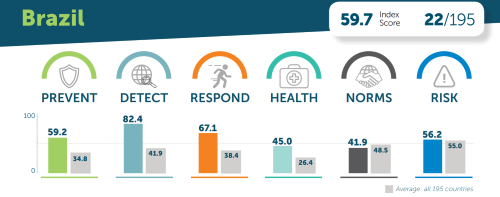 Figure 3; Relative performance to the average of 196 countries | 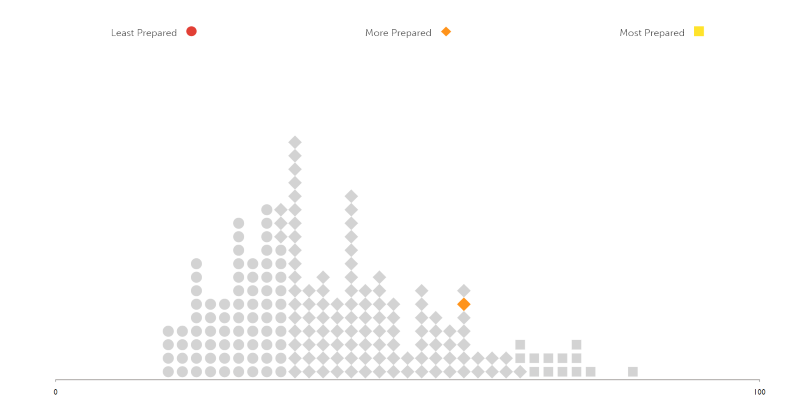 Figure 4; Overall Ranking |
In November 2019, the Global Health Security Index (GHS) was released by three leading research organizations: The Nuclear Threat Initiative (NTI), Johns Hopkins Center for Health Security (JHU), and the Economists Intelligence Unit (EIU). The goal of the GHS is to help understand and measure improvement in the global capacity to prevent, detect, and respond to infectious disease threats [32] . It is assumed to be the first comprehensive assessment of global health security preparedness. Considering the fact that it directly estimates countries' preparedness for the emergence of deadly pathogens and epidemic or pandemic diseases, it establishes a valuable tool in studying pandemic preparedness. The GHS covers 195 countries and territories and is based on a comprehensive framework that comprises 140 questions organized around six categories: Prevention, Detection, and reporting, Rapid response, Health system, Compliance with international norms, and risk environment. It relies on open-source data. The United States, the United Kingdom, and the Netherlands topped the global 2019 GHS ranking.
The GHS attempts to "illuminate preparedness and capacity gaps to increase both political will and financing to fill them" [33] .
Figure 3 shows how Brazil positions in comparison to the average of 196 included countries. Except for "health", measuring health care access and the sufficiency and robustness of the health system in treating the sick and protecting health workers, and "norms", indicating the willingness to improve national capacity, adhering to international norms and financing plans to address gaps, Brazil points above average in each category. In Figure 4, depicting Brazil in the upper third of all countries assessed, Brazil has been marked a "more prepared country".
Particularly striking, as it corresponds to observed reality is the placement of Brazil in the "risk"-category, covering the overall risk environment and country vulnerability to biological threats. There, Brazil performs especially bad in "Political and security risk" placing 70/195, "Socioeconomic resilicence" (101/196), and "public health vulnerabilities" (86/196). The "Socioeconomic resilience" indicator under the "Risk environment"-category covers among others poverty, "political and security risk" government effectiveness or risk of social unrest, and "public health vulnerabilities" access to potable water and sanitation as well as public health spending per capita.
However, the results of the Index must be enjoyed carefully in regard to the current COVID-19 pandemic. When comparing those countries that were supposed "most prepared" according to the index to actual data of COVID-19 cases and deaths, counterintuitively those occurring to be "prepared" appear to face particularly high caseloads and deaths. On April 7th, 12 of the 20th most prepared countries were in the top 20 globally for COVID-19 deaths. Consequently, analysts declare that the "Pandemic Preparedness Index itself is unprepared for COVID-19" [34] . Therefore, the organizations responsible for the index state that a countries' "score or rank do not indicate that the country is adequately prepared to respond to potentially catastrophic infectious disease outbreaks" and highlight the role of effective political leadership. This argument puts forward, that certain countries should have been able to respond in a better way to the Covid-19 health crisis than what they have done as they were, in theory, better prepared. In addition, it is told that "the COVID-19 pandemic has become a proof point for its main finding: national health security is fundamentally weak around the world." [35] .
The GHS attempts to "illuminate preparedness and capacity gaps to increase both political will and financing to fill them" [33] .
Figure 3 shows how Brazil positions in comparison to the average of 196 included countries. Except for "health", measuring health care access and the sufficiency and robustness of the health system in treating the sick and protecting health workers, and "norms", indicating the willingness to improve national capacity, adhering to international norms and financing plans to address gaps, Brazil points above average in each category. In Figure 4, depicting Brazil in the upper third of all countries assessed, Brazil has been marked a "more prepared country".
Particularly striking, as it corresponds to observed reality is the placement of Brazil in the "risk"-category, covering the overall risk environment and country vulnerability to biological threats. There, Brazil performs especially bad in "Political and security risk" placing 70/195, "Socioeconomic resilicence" (101/196), and "public health vulnerabilities" (86/196). The "Socioeconomic resilience" indicator under the "Risk environment"-category covers among others poverty, "political and security risk" government effectiveness or risk of social unrest, and "public health vulnerabilities" access to potable water and sanitation as well as public health spending per capita.
However, the results of the Index must be enjoyed carefully in regard to the current COVID-19 pandemic. When comparing those countries that were supposed "most prepared" according to the index to actual data of COVID-19 cases and deaths, counterintuitively those occurring to be "prepared" appear to face particularly high caseloads and deaths. On April 7th, 12 of the 20th most prepared countries were in the top 20 globally for COVID-19 deaths. Consequently, analysts declare that the "Pandemic Preparedness Index itself is unprepared for COVID-19" [34] . Therefore, the organizations responsible for the index state that a countries' "score or rank do not indicate that the country is adequately prepared to respond to potentially catastrophic infectious disease outbreaks" and highlight the role of effective political leadership. This argument puts forward, that certain countries should have been able to respond in a better way to the Covid-19 health crisis than what they have done as they were, in theory, better prepared. In addition, it is told that "the COVID-19 pandemic has become a proof point for its main finding: national health security is fundamentally weak around the world." [35] .
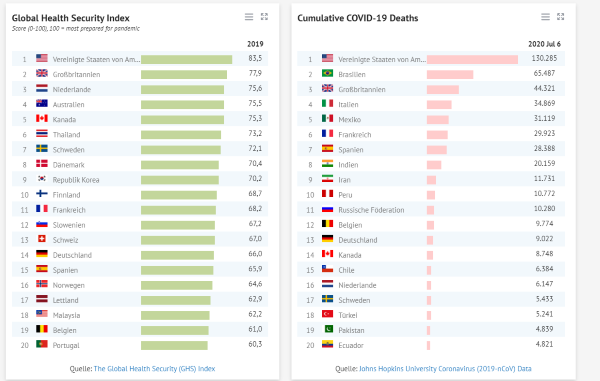
Figure 5; GHS index vs. cumulative deaths from COVID-19 by countries
As Figure 5 depicts, the pre-COVID-19 GHS index is if in no, in small association to countries' actual coronavirus outbreaks, which is explicitly presented in the cases of the US and the UK, which perform good on the GHS index but poor on COVID-19. Health systems supposed preparedness' and responses do accordingly not match, hinting at the GHS index greatly overestimating the capacity and preparedness of certain healthcare systems and underestimated others, such as Germany and South Korea which rank much better on evolving indices during COVID-19 [36] . Therefore, retrospectively, as the index stems from 2019, it is of little use and unmeaningful when reviewing countries' preparedness to COVID-19. Still, those factors going beyond the sheer health care system preparedness such as "Risk environment" are still valid, since they outline political and social risk factors in case of a pandemic outbreak and thus contribute to my goal of identifying particular Brazilian preconditions.
Additional country-level indices that measure countries' preparedness to face pandemics are the COVID-19 Safety-, Risk, and Treatment Efficiency Indices presented by Deep Knowledge Group, a consortium of profit and non-profit organizations and covering 150 countries by 72 metrics [37] . The Covid-19 safety index was produced after the initial outbreaks in March 2020 and remains preliminary and dynamic as the pandemic evolves. The “Safety” Index comprises "Quarantine efficiency", "Government management efficiency", "Monitoring and detection" and "Emergency treatment readiness". Although the results are preliminary, for the moment it is topped by Israel, Germany, and South Korea. Comparing both indices, there is no correlation in the GHS ranks and Covid-19 Safety ranks as it can be noted that the two top performers in the GHS – the United-Kingdom and United-States – are not in the top 40 performers in the Covid-19 Safety Index.
Additional country-level indices that measure countries' preparedness to face pandemics are the COVID-19 Safety-, Risk, and Treatment Efficiency Indices presented by Deep Knowledge Group, a consortium of profit and non-profit organizations and covering 150 countries by 72 metrics [37] . The Covid-19 safety index was produced after the initial outbreaks in March 2020 and remains preliminary and dynamic as the pandemic evolves. The “Safety” Index comprises "Quarantine efficiency", "Government management efficiency", "Monitoring and detection" and "Emergency treatment readiness". Although the results are preliminary, for the moment it is topped by Israel, Germany, and South Korea. Comparing both indices, there is no correlation in the GHS ranks and Covid-19 Safety ranks as it can be noted that the two top performers in the GHS – the United-Kingdom and United-States – are not in the top 40 performers in the Covid-19 Safety Index.
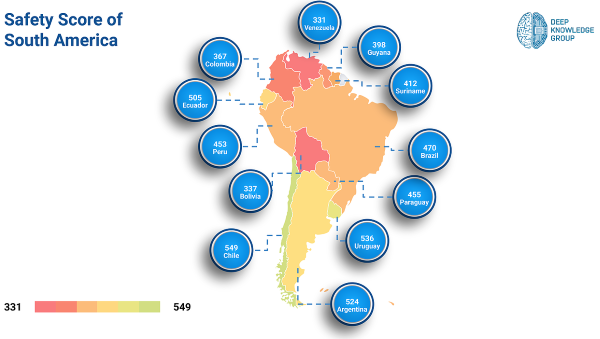 Figure 6; Safety Scores of South American countries | 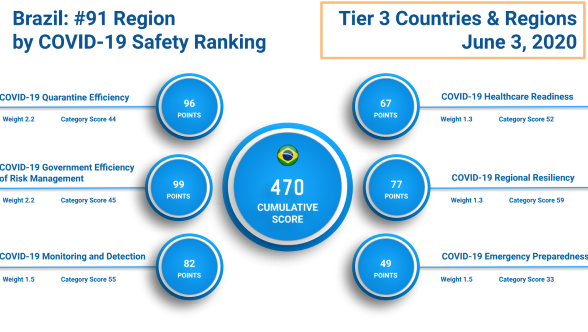 Figure 7; detailed results for Brazil |
1.6 Brazil in the "COVID-19 Regional Safety Index"
In Deep Knowledge Groups "COVID-19 Regional Safety Index" Brazil is grouped in tier 3 ranking overall 91st place (of a total number of 200 countries ) by June 3rd with a cumulative score of 470 points, slightly higher than the regional South American average of 445 points but significantly lower than Chile (rank 41), Uruguay (51) or Argentina (62). The index is constructed around 60 parameters which are aggregated from each of the index's 6 categories ("COVID-19 Quarantine Efficiency", "COVID-19 Government Efficiency of Risk Management", "COVID-19 Monitoring and Detection", "COVID-19 Healthcare Readiness", "COVID-19 Regional Resiliency", "COVID-19 Emergency Preparedness"). Amongst the parameters are population density, number of cases, scale and scope of region-wide lockdown and length of quarantine or fines (under the category "Quarantine Efficiency"), the numbers of tests conducted per day and if the region has a significant shortage of COVID-19 tests ("COVID-19 monitoring and detection"), hospital beds and number of doctors ("Healthcare readiness"), literacy rate, poverty rate, size of the elderly population, and total transportation network size ("Regional resiliency"), government effectiveness, E-Government Development Index, number of internet users per 1000 ("Government Efficiency of Risk management"). The specific parameters for "Emergency preparedness" are not publicly disclosed.
For a more detailed look at the methodology I recommend using this link: http://analytics.dkv.global/covid-regional-assessment-200-regions/full-report.pdf
Figure 6 shows a broad variety of Regional Safety Scores for South America. Put into perspective Brazil's comparatively low score as the largest economy in Southern America, displayed in Figure 4, can be traced back to slow responses in lockdown measures. The result for those countries scoring significantly higher than average regional safety scores in South America (Chile, Uruguay, Peru, and Ecuador) is mainly attributed to very early, proactive government responses, specific policies and COVID-19 measures [38] and less to differences in healthcare modernization or development.
Figure 7 covers more detailed results for the Brazilian comparatively low score. "Monitoring and Detection", that is the scope of diagnostic methods, and testing efficiency is particularly weak as well as "Healthcare readiness" comprising COVID-19 equipment availability. "Government Efficiency and Risk Management", scoring 99 is lower than this of Chile, Argentina, Uruguay, and Ecuador. The category is made up of indicators such as rapid emergency mobilization, legislative effectiveness, and efficiency of Government structure.
What can be concluded from these results? According to the report, Tier 3 group in the study is made up of countries that scored significantly lower in cumulative regional safety scores in the analysis than expected given their general pre-pandemic levels of Quarantine Efficiency, Government Efficiency of Risk Management, Monitoring and Detection Efficiency, Health Readiness, Regional Resilience, and Emergency Preparedness [39] . Theoretically, given their healthcare, governmental, and crisis management capacities, these countries should have been prepared better, but in practice failed to pass the "stress test". This finding matches the GHS index in which Brazil was also classified as a "more prepared" country. Thus, the presumed reasons leading to scoring relatively low among South American countries and Tier 3 regions in the index are governmental strategies used to combat pandemics (ibid.). Resulting from this main hypothesis analyzing both indices that governmental strategies and policy factors play a crucial role in pandemic evolution in Brazil, I will set this as a special focus in my further analysis.
For a more detailed look at the methodology I recommend using this link: http://analytics.dkv.global/covid-regional-assessment-200-regions/full-report.pdf
Figure 6 shows a broad variety of Regional Safety Scores for South America. Put into perspective Brazil's comparatively low score as the largest economy in Southern America, displayed in Figure 4, can be traced back to slow responses in lockdown measures. The result for those countries scoring significantly higher than average regional safety scores in South America (Chile, Uruguay, Peru, and Ecuador) is mainly attributed to very early, proactive government responses, specific policies and COVID-19 measures [38] and less to differences in healthcare modernization or development.
Figure 7 covers more detailed results for the Brazilian comparatively low score. "Monitoring and Detection", that is the scope of diagnostic methods, and testing efficiency is particularly weak as well as "Healthcare readiness" comprising COVID-19 equipment availability. "Government Efficiency and Risk Management", scoring 99 is lower than this of Chile, Argentina, Uruguay, and Ecuador. The category is made up of indicators such as rapid emergency mobilization, legislative effectiveness, and efficiency of Government structure.
What can be concluded from these results? According to the report, Tier 3 group in the study is made up of countries that scored significantly lower in cumulative regional safety scores in the analysis than expected given their general pre-pandemic levels of Quarantine Efficiency, Government Efficiency of Risk Management, Monitoring and Detection Efficiency, Health Readiness, Regional Resilience, and Emergency Preparedness [39] . Theoretically, given their healthcare, governmental, and crisis management capacities, these countries should have been prepared better, but in practice failed to pass the "stress test". This finding matches the GHS index in which Brazil was also classified as a "more prepared" country. Thus, the presumed reasons leading to scoring relatively low among South American countries and Tier 3 regions in the index are governmental strategies used to combat pandemics (ibid.). Resulting from this main hypothesis analyzing both indices that governmental strategies and policy factors play a crucial role in pandemic evolution in Brazil, I will set this as a special focus in my further analysis.
1.7 Preparedness overall summary
As large disparities in Brazil's healthcare system persist and healthcare is unequally distributed in the country, Brazil's healthcare system is not resilient to a mass pandemic. Brazil's states do not possess the recommended counts of hospital beds with intensive treatment [40] and its health system is stressed already with infectious diseases. In addition to that, underfunding presents an urgent issue for the healthcare system. In recent times, there were numerous incidents unfolding around the catastrophic state of public hospitals [41] . Werneck et al. (2020) point out that "the COVID-19 pandemic has reached the Brazilian population in a scenario of extreme
vulnerability, with high unemployment rates and severe budget cuts in social policies."
Nearly half of the population is without regular employment and thus extremely vulnerable to the economic effects of quarantine measures. When there is a public shutdown, there wouldn't be any guaranteed income which they depend on in their work as housekeepers, street vendors, day laborers, etc [42] . As many as three-thirds of Brazilians live in cities and a great part in precarious housing conditions in low-income neighborhoods known as favelas, critically aggravating the adoption of social distancing measures. Little or no access to sanitation and a high population density present a surrounding where a highly contagious virus is very likely to spread quickly.
Brazil's indigenous communities are especially vulnerable. Brazil's current president has not turned out a special guardian of this population as he attempts to legalize commercial activities such as mining in the indigenous regions [43] Little is known about the immune response of the indigenous population to the virus and communities live often with precarious medical supply [44] . The political situation prior to the first cases in February and Bolsonaro's presidency was already heated. The country experienced years of economic recession and mass unemployment with no significant relaxation before COVID-19 [45] . These factors further weaken the country's stand and preconditions in times of a major health crisis.
vulnerability, with high unemployment rates and severe budget cuts in social policies."
Nearly half of the population is without regular employment and thus extremely vulnerable to the economic effects of quarantine measures. When there is a public shutdown, there wouldn't be any guaranteed income which they depend on in their work as housekeepers, street vendors, day laborers, etc [42] . As many as three-thirds of Brazilians live in cities and a great part in precarious housing conditions in low-income neighborhoods known as favelas, critically aggravating the adoption of social distancing measures. Little or no access to sanitation and a high population density present a surrounding where a highly contagious virus is very likely to spread quickly.
Brazil's indigenous communities are especially vulnerable. Brazil's current president has not turned out a special guardian of this population as he attempts to legalize commercial activities such as mining in the indigenous regions [43] Little is known about the immune response of the indigenous population to the virus and communities live often with precarious medical supply [44] . The political situation prior to the first cases in February and Bolsonaro's presidency was already heated. The country experienced years of economic recession and mass unemployment with no significant relaxation before COVID-19 [45] . These factors further weaken the country's stand and preconditions in times of a major health crisis.
2 Sense Making
In the Boin et al. (2017) (cf. 1) crisis management framework, "Sense Making" is coined a "collecting and processing [of] information that will help crisis managers to detect an emerging crisis and understand the significance of what is going on during a crisis." Thus the following section will cover COVID-19 progression in Brazil using central figures and statistics.
Nonetheless, one has to be aware that COVID-19 statistics of Brazil are widely regarded as incomplete. It is assumed, that real statistics on cases and deaths are a lot higher as Brazil's testing is inadequate [46] . According to estimations, numbers could be as much as 7x-15x higher than officially reported and death rates twice as high [47] .
On June 06th/07th Brazil's Federal Government removed official statistics such as cumulative COVID-19 infection and death totals from the Health Ministry's website claiming sub-federal levels of government, such as municipalities and federal states inflated and over-reported numbers in order to gain federal funding [48] [49] . Also in early June, the daily presentation of figures was moved from afternoon to late in the evening. At this time former health minister Luis Henrique Mandetta called the actions and missing of public data on recognized epidemiological measures a "tragedy for the health system" (ibid.). After pressure rose from parliament and the Supreme Court's (Brazil's highest court) ruling that the Ministry must resume releasing all epidemiological data, a new website was set up (which can be accessed here: https://covid.saude.gov.br/) and the numbers were brought back [50] .
After the arrival of the virus and the first cases of the infection being registered among the higher social classes that travel internationally, COVID-19 was often coined a disease of the richer class. Soon however, due to living conditions and poverty which promote transmission, began to rage within the poorer parts of the population where it is believed to have far more damaging effects.
Nonetheless, one has to be aware that COVID-19 statistics of Brazil are widely regarded as incomplete. It is assumed, that real statistics on cases and deaths are a lot higher as Brazil's testing is inadequate [46] . According to estimations, numbers could be as much as 7x-15x higher than officially reported and death rates twice as high [47] .
On June 06th/07th Brazil's Federal Government removed official statistics such as cumulative COVID-19 infection and death totals from the Health Ministry's website claiming sub-federal levels of government, such as municipalities and federal states inflated and over-reported numbers in order to gain federal funding [48] [49] . Also in early June, the daily presentation of figures was moved from afternoon to late in the evening. At this time former health minister Luis Henrique Mandetta called the actions and missing of public data on recognized epidemiological measures a "tragedy for the health system" (ibid.). After pressure rose from parliament and the Supreme Court's (Brazil's highest court) ruling that the Ministry must resume releasing all epidemiological data, a new website was set up (which can be accessed here: https://covid.saude.gov.br/) and the numbers were brought back [50] .
After the arrival of the virus and the first cases of the infection being registered among the higher social classes that travel internationally, COVID-19 was often coined a disease of the richer class. Soon however, due to living conditions and poverty which promote transmission, began to rage within the poorer parts of the population where it is believed to have far more damaging effects.
2.1 COVID-19 Evolution in Brazil
On February 25, 2020, the Brazilian Ministry of Health confirmed its (supposedly) first COVID-19 case. The patient, a 61-year-old Brazilian man brought the disease from Lombardy in Northern Italy. The man was quickly isolated, received precautionary care and his contacts were traced. The premier Brazilian case is also considered the first (confirmed) COVID-19 case in South America. By June 29th, 2020, according to Johns Hopkins University (2020), 1.344.143 cases and 57.622 deaths of COVID-19 have been confirmed, ranking the country second behind the US [51] .
2.2 Tracking Cumulative Cases and New Infections
Figure 8; newly reported cases per day | Figure 9; cumulative cases by notification date |
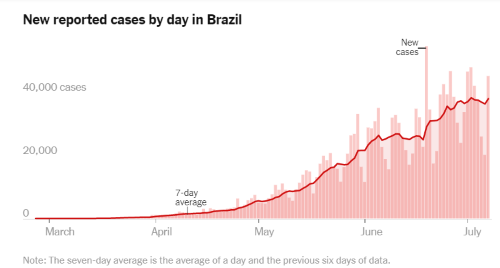 Source: Brazil Coronavirus Map and Case Count By The New York Times (Updated July 8, 2020, 4:36 A.M. E.T.) | 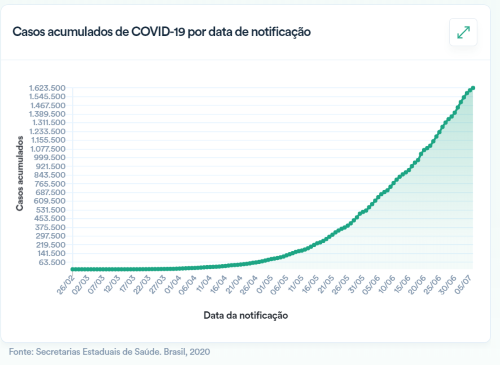 Source: Painel de casos de doença pelo coronavírus 2019 (COVID-19) no Brasil pelo Minísteria da Saúde (Brazil Health Ministry Panel, see link above) |
Figure 8 depicts newly reported cases by day in Brazill as well as the seven-day average. From the time the first case was reported to the end of March (on 31.03., 1.138 new cases were reported and the 7-day average was at 502 cases) the curve remained relatively low. In April, rapid growth can be already observed: 1st of April saw 1.117 new cases and a 629 7-day average, while at the end of April (April 30th) newly reported cases rose at 7.502 and a 5.385 average. Comparing those values to the number of cumulative cases in Figure 9, by the beginning of May a cumulative total of cases of 91.604 was counted, as opposed to 5744 at the end of March.
In May 2020, the virus' spread in Brazil was further accelerated at accumulative case numbers enter the realm of six digits (101.227 cumulative confirmed cases on May 3rd). The number of recently identified cases reached a new height on May 30th, as 33.274 were newly tested positive for COVID-19 with a 7-day average of 21.477 who were positively tested the previous week. The rapid pace of COVID-19 spread can be further witnessed in June as total cumulative confirmed cases increase from 526.447 to almost one and a half million (1.402.041 cases on Jun 30th) within a month according to the ministry of health. June 19th saw a record-breaking figure of identified cases as they counted 54,771 and an almost 30.000 weekly average.
The New York Times counting method is either composed of a combination of confirmed cases and probable cases or the total of confirmed counts when they are available. Confirmed cases being "counts of individuals whose coronavirus infections were confirmed by a laboratory test.", probable cases counting "individuals who did not have a confirmed test but were evaluated using criteria developed by national and local governments". This alternative approach and the fact that authorities often revise data might explain why counts are somewhat different from the Ministry of Health's source on new cases per day.
Figure 9's cumulative confirmed cases show how the outbreak has expanded, counting every individual who has ever tested positive and paying no regard to whether a given individual has yet recovered. As an upward bend in the curve indicates a time of explosive growth in coronavirus cases, that the Brazilian curve has neither been flattened nor does it show any trend of decline. On the other hand it must be noted, that due to delays in reporting and to limited testing (as mentioned above) the actual number of cases is likely to be much higher than the number of confirmed cases.
In May 2020, the virus' spread in Brazil was further accelerated at accumulative case numbers enter the realm of six digits (101.227 cumulative confirmed cases on May 3rd). The number of recently identified cases reached a new height on May 30th, as 33.274 were newly tested positive for COVID-19 with a 7-day average of 21.477 who were positively tested the previous week. The rapid pace of COVID-19 spread can be further witnessed in June as total cumulative confirmed cases increase from 526.447 to almost one and a half million (1.402.041 cases on Jun 30th) within a month according to the ministry of health. June 19th saw a record-breaking figure of identified cases as they counted 54,771 and an almost 30.000 weekly average.
The New York Times counting method is either composed of a combination of confirmed cases and probable cases or the total of confirmed counts when they are available. Confirmed cases being "counts of individuals whose coronavirus infections were confirmed by a laboratory test.", probable cases counting "individuals who did not have a confirmed test but were evaluated using criteria developed by national and local governments". This alternative approach and the fact that authorities often revise data might explain why counts are somewhat different from the Ministry of Health's source on new cases per day.
Figure 9's cumulative confirmed cases show how the outbreak has expanded, counting every individual who has ever tested positive and paying no regard to whether a given individual has yet recovered. As an upward bend in the curve indicates a time of explosive growth in coronavirus cases, that the Brazilian curve has neither been flattened nor does it show any trend of decline. On the other hand it must be noted, that due to delays in reporting and to limited testing (as mentioned above) the actual number of cases is likely to be much higher than the number of confirmed cases.
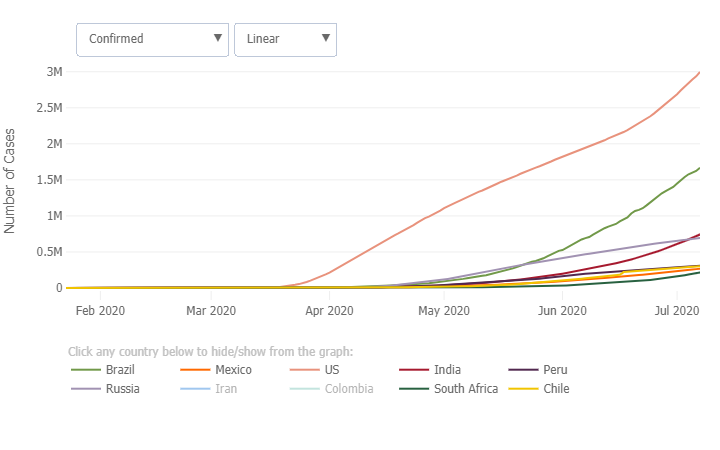
Figure 10; Cumulative Cases By Date
Putting these numbers into perspective by comparing across regions, I used the statistical tools presented by John Hopkins University Coronavirus Resource Center's to adjust for population [52] (for Figures 10 and 11).
On the right-hand side, the graph shows the cumulative confirmed number of cases by date. Selected countries compared to Brazil the US, India, Russia, Peru, Chile, and Mexico as they position amongst the premier 20 countries concerning COVID-19 cases. From the graph can be derived, how the virus spread in Brazil is even comparatively extended to other countries dealing with the outbreak. As it passed Russia by end of May Brazil became the country with the second-highest amount of total (confirmed) cases.
On the right-hand side, the graph shows the cumulative confirmed number of cases by date. Selected countries compared to Brazil the US, India, Russia, Peru, Chile, and Mexico as they position amongst the premier 20 countries concerning COVID-19 cases. From the graph can be derived, how the virus spread in Brazil is even comparatively extended to other countries dealing with the outbreak. As it passed Russia by end of May Brazil became the country with the second-highest amount of total (confirmed) cases.
However, looking at the chart of Figure 11 underneath which assesses countries confirmed cases by date and 100.000 individuals, at least according to official statistics Chile, Peru, and the US have higher confirmed cases in relation to 100.000 population.
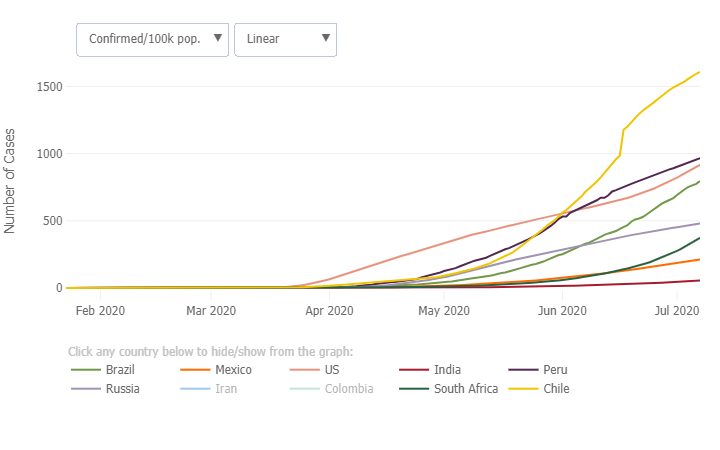
Figure 11; Cases per 100k population
This result can be partly attributed to the testing that is carried out in countries. Figure 12 [53] shows that Brazil conducts considerably fewer tests than the countries previously compared to in relative caseload, meaning that these logically report more cases as they find more. Thus, following this logic and as already mentioned before, estimations expect high dark counts and unreported data for COVID-19 figures in Brazil due to little testing, leading to the assumption of likely even more critical circumstances.
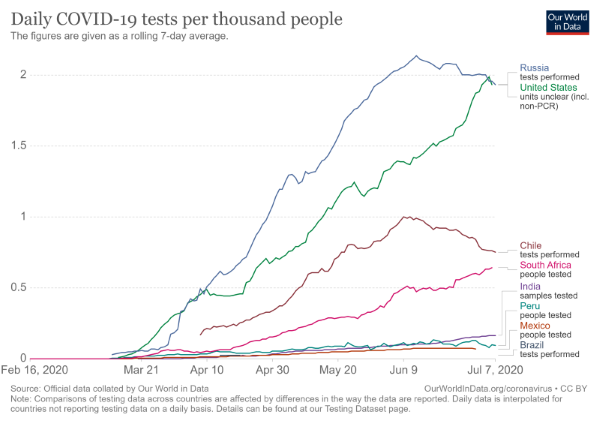
Figure 12; COVID-19 Tests per Thousand People
2.3 Deaths and Mortality Rate
Figure 13; Brazil's number of COVID-19 deaths 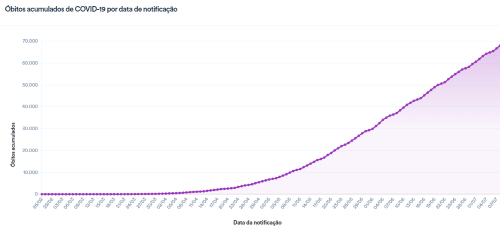 | Figure 14; Brazil's reported COVID-19 related deaths by day 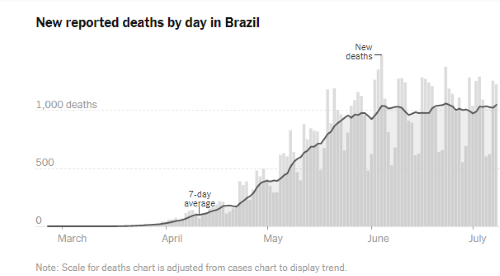 |
No progress has been made in bending the curve when one looks at the trends of deaths over time and daily reported deaths (Figure 13 & 14). On the contrary, the total numbers of deaths increase counting 60.632 deaths on July 1st. The numbers on newly reported deaths appear to constantly fluctuate around 1.000 and 1.200 cases per day since May displaying a clear upward trending. Here it must be also kept in mind, that the actual total death toll from COVID-19 is likely to be higher than the number of confirmed deaths.
Put in a nutshell, the COVID-19 pandemic in Brazil is by no means controlled in Brazil and far from being so.
Put in a nutshell, the COVID-19 pandemic in Brazil is by no means controlled in Brazil and far from being so.
2.4 Accounting for Brazilian interstate heterogeneity
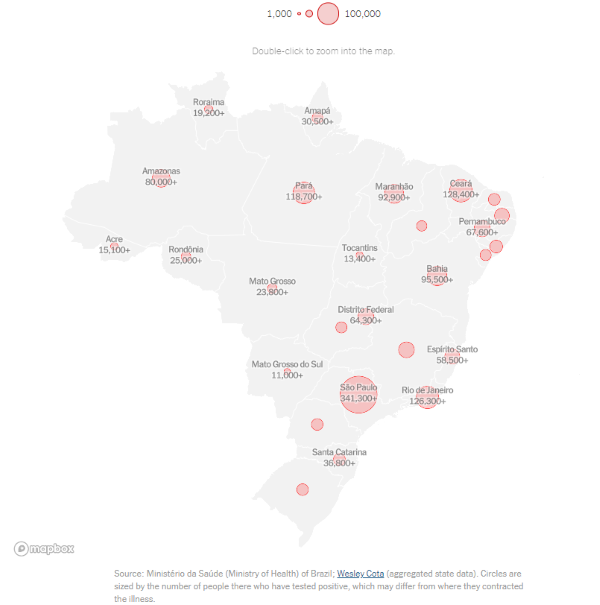
Source: Ministério da Saúde (Ministry of Health) of Brazil
Brazil is a country of continental dimensions and regional cultural, political, demographical, and economic variations persist between Brazil's states. Likewise, the regional epidemic intensity and dynamics differ. Scholars have already indicated that the characteristics of Brazilian states may significantly affect state epidemic dynamics, making them differ substantially [54] . These substantial differences feed "the need for optimal containment policies that are also heterogeneous and varying in extent and duration for different states." Borelli and Goes (2020) state that "disregarding the importance of such heterogeneities and not taking them into account to coordinate containment policies may amplify both the severity of the economic recession and the number of infected and deaths resulting from the epidemic."
Indeed there are great regional disparities in Brazil's COVID-19 outbreak. Brazil's most affected state is São Paulo, where the first South American case was reported, with 341.365 cases and 16.788 deaths on July 8th, 2020. The capitals of six federal states are centres of massive outbreaks: São Paulo (São Paulo), Rio de Janeiro (Rio de Janeiro), Fortaleza (Ceará), Belém (Pará), Manaus (Amazonas), and Recife (Pernambuco). Although regions of the North and Northeast count fewer total cases, they rely on a weaker public health system and some four states had already 90% of ICU bed capacity covered in early June. Medical resources are further unequally distributed as 17 out of 27 states fail to meet the benchmark of 1 ICU bed per 10.000 people [55]
Indeed there are great regional disparities in Brazil's COVID-19 outbreak. Brazil's most affected state is São Paulo, where the first South American case was reported, with 341.365 cases and 16.788 deaths on July 8th, 2020. The capitals of six federal states are centres of massive outbreaks: São Paulo (São Paulo), Rio de Janeiro (Rio de Janeiro), Fortaleza (Ceará), Belém (Pará), Manaus (Amazonas), and Recife (Pernambuco). Although regions of the North and Northeast count fewer total cases, they rely on a weaker public health system and some four states had already 90% of ICU bed capacity covered in early June. Medical resources are further unequally distributed as 17 out of 27 states fail to meet the benchmark of 1 ICU bed per 10.000 people [55]
Social Health Inequalities
Given that Brazil has a remarkably diverse population, a pandemic inevitably does not affect all parts of society in the same way. Instead, socioeconomic inequalities play a huge part in a pandemic development as there are particularly vulnerable populations [56] . Hence, next to regional health inequalities, social differences are an aspect necessarily to consider in an analysis. In Brazil, extreme disparities lead to Black Brazilians and Indigenous people getting sick and dying at much higher rates.
About a quarter of Brazilians have access to its private healthcare sector, mainly middle and high-income Brazilians. 51% of all ICU beds are allocated in private hospitals with Black and Pardo (mixed ethnicity) making up 15-20% of those covered by private health insurance plans. 67% of the public health system users identify as black.
Concerns about the virus' impact on the favelas were voiced, as mentioned before in Preparedness, already in advance. 1.5 Mio. mostly dark-skinned people alone living in Rio de Janeiro's favelas, the population is predominantly poor with some considerable amount living in precarious, crowded conditions without running water and health care access that is limited. A recent survey found already that due to the lack of reliable statistics the infection rate in the favelas could be as much as 30% higher [57] than the official count. There have been preliminary findings of an ethnicity effect on mortality with Pardo and Black populations being at higher risks when exposed to COVID-19 [58] .
Reports marked the devastating effect of COVID-19 on indigenous communities as well, a population heavily vulnerable when exposed to the virus. Historically speaking, imported diseases have often caused decimation among the indigenous population. As their living conditions make hygiene measures and social distancing considerably more difficult, many suffer from malnutrition and their medical care is precarious anyway, Brazilian 900.000 indigenous people face high death tolls and case number in face of the current pandemic. Some live that remoted, that hospitals are days away. Bolsonaro's government is harshly accused to have failed to protect the communities from the disease [59] . Several groups went into self-isolate by advancing deep into the forest. Under the rule of Bolsonaro, indigenous communities were already under severe threat. Brazil has dismantled environmental protections of the Amazon, allowing deforestation. Furthermore, there is an increase in an illegal land grab violating indegenous land rights.
About a quarter of Brazilians have access to its private healthcare sector, mainly middle and high-income Brazilians. 51% of all ICU beds are allocated in private hospitals with Black and Pardo (mixed ethnicity) making up 15-20% of those covered by private health insurance plans. 67% of the public health system users identify as black.
Concerns about the virus' impact on the favelas were voiced, as mentioned before in Preparedness, already in advance. 1.5 Mio. mostly dark-skinned people alone living in Rio de Janeiro's favelas, the population is predominantly poor with some considerable amount living in precarious, crowded conditions without running water and health care access that is limited. A recent survey found already that due to the lack of reliable statistics the infection rate in the favelas could be as much as 30% higher [57] than the official count. There have been preliminary findings of an ethnicity effect on mortality with Pardo and Black populations being at higher risks when exposed to COVID-19 [58] .
Reports marked the devastating effect of COVID-19 on indigenous communities as well, a population heavily vulnerable when exposed to the virus. Historically speaking, imported diseases have often caused decimation among the indigenous population. As their living conditions make hygiene measures and social distancing considerably more difficult, many suffer from malnutrition and their medical care is precarious anyway, Brazilian 900.000 indigenous people face high death tolls and case number in face of the current pandemic. Some live that remoted, that hospitals are days away. Bolsonaro's government is harshly accused to have failed to protect the communities from the disease [59] . Several groups went into self-isolate by advancing deep into the forest. Under the rule of Bolsonaro, indigenous communities were already under severe threat. Brazil has dismantled environmental protections of the Amazon, allowing deforestation. Furthermore, there is an increase in an illegal land grab violating indegenous land rights.
3 Decision-Making and coordination
Boin et al. (2017) define decision-making as "making critical calls on strategic dilemmas and orchestrating a coherent response to implement those decisions.". Following the conclusion of the "Sense-Making" section that it hasn't been managed to bend the pandemic curve in Brazil and the COVID-19 outbreak being far from controlled, this part concerning "Decision-Making and Coordination" serves to trace measures which were adopted by political units and their timing in relation to the trends and dynamics of the pandemic.
Widely regarded as having become one of the world's epicentres of the coronavirus pandemic, Brazil saw major conflicts in designing and implementing policies to combat COVID-19, alongside with incoordination between federal and regional powers over containment policies [60] . Overall, Brazil has no national approach to corona crisis management; there is a lack of central control by the government in Brasilia, and horizontal coordination between federal states is weak. Moreover, cleavages within the federal government on the coronavirus handling lead to the resignation of two national health ministers. While state governments implemented containment policies aiming at more severe measures, the federal government publicly downplayed the threat and seriousness of the disease. Favouring an "economy-over-health"-approach it refused to initiate a general COVID-19 lockdown or effective curve-bending strategies [61] .
Brazil's president Jair Bolsonaro is accused of undermining measures adopted by Brazil's federal states as his supporters did not necessarily follow containment policies adopted by the state governors. Bolsonaro has shown repeatedly attending public events and demonstrations directed at the withdrawal from shutdowns and COVID-related restrictions calling for a return of normality. The president further advocates the use of chloroquine, a medication which has not scientifically proven to be effective against COVID-19 (LINK).
Besides its public health disaster, Brazil finds itself amid serious power struggles between the country's constitutional institutions.
Widely regarded as having become one of the world's epicentres of the coronavirus pandemic, Brazil saw major conflicts in designing and implementing policies to combat COVID-19, alongside with incoordination between federal and regional powers over containment policies [60] . Overall, Brazil has no national approach to corona crisis management; there is a lack of central control by the government in Brasilia, and horizontal coordination between federal states is weak. Moreover, cleavages within the federal government on the coronavirus handling lead to the resignation of two national health ministers. While state governments implemented containment policies aiming at more severe measures, the federal government publicly downplayed the threat and seriousness of the disease. Favouring an "economy-over-health"-approach it refused to initiate a general COVID-19 lockdown or effective curve-bending strategies [61] .
Brazil's president Jair Bolsonaro is accused of undermining measures adopted by Brazil's federal states as his supporters did not necessarily follow containment policies adopted by the state governors. Bolsonaro has shown repeatedly attending public events and demonstrations directed at the withdrawal from shutdowns and COVID-related restrictions calling for a return of normality. The president further advocates the use of chloroquine, a medication which has not scientifically proven to be effective against COVID-19 (LINK).
Besides its public health disaster, Brazil finds itself amid serious power struggles between the country's constitutional institutions.
3.1 Timeline of national measures

Figure 15; Brazil facing COVID-19: Key events and measures
Already in early February, the then-Minister of Health, Luiz Henrique Mandetta (a physician), declared a public health emergency. From March onwards, the government ordered the partial and temporary closure of the borders, a measure that was successively extended in terms of both geographic area and duration. The "quarantine act" from February 6th lays the basic legal framework to the imposition of isolation and quarantine measures for people and animals; laboratory tests, vaccinations, exams, and medical treatments; the temporary restriction on the entry and exit of people and goods from the country; the requisition of private goods and services by the State, among others [62] . It provides for measures such as isolation (separation of infected from others in order to avoid contamination or spread), quarantine (restriction of activities of persons suspected of being infected), medical examinations, laboratory tests, collection of clinical samples and much more. On March 11th, an ordinance was issued to determine the duration of measures (fourteen days for isolation, extendable for the same period; up to forty days for quarantine, extendable indefinitily). It indicated that isolation should preferably occur at home and provided several operational details related to exams and tests.
Following the end of January, executives on the state and municipal levels had been taking various and increasingly limiting measures to restrict public life. Thus, they have departed from the President’s instructions and provoked him to start an aggressive campaign against their corona crisis management, for instance the "Brazil cannot stop"-campaign (“Brasil não pode parar”) which was stopped by the Supreme Court (covered below). As the autonomy of federal states and municipalities in acting in public health emergency situations was reaffirmed by the Supreme Court in the face of Bolsonaro’s strategy to derail the quarantine, I cover the state-level crisis management in depth in the subsequent section picking the example of São Paulo.
Given the federal level's vacuum on acting in face of the pandemic, by the end of this writing, there were 16197 municipal and almost 800 state-issued normative acts in relation to the COVID-19 crisis. In general, most governors were imposing farreaching lockdowns in mid-March.
Following the end of January, executives on the state and municipal levels had been taking various and increasingly limiting measures to restrict public life. Thus, they have departed from the President’s instructions and provoked him to start an aggressive campaign against their corona crisis management, for instance the "Brazil cannot stop"-campaign (“Brasil não pode parar”) which was stopped by the Supreme Court (covered below). As the autonomy of federal states and municipalities in acting in public health emergency situations was reaffirmed by the Supreme Court in the face of Bolsonaro’s strategy to derail the quarantine, I cover the state-level crisis management in depth in the subsequent section picking the example of São Paulo.
Given the federal level's vacuum on acting in face of the pandemic, by the end of this writing, there were 16197 municipal and almost 800 state-issued normative acts in relation to the COVID-19 crisis. In general, most governors were imposing farreaching lockdowns in mid-March.
3.2 State-level response of Sao Paolo
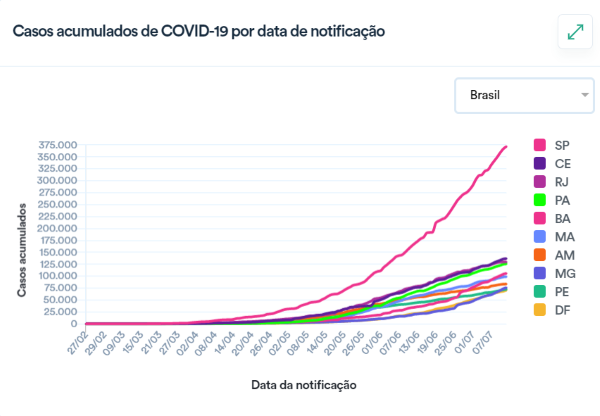
Figure 16; regional variation of coronavirus caseload
Brazil's COVID-19 response takes place in the context of federalism. The Brazilian president, heading the executive branch of the state appears not pursue an active nation anti-coronavirus approach [63] . In Brazil there is no national approach to corona crisis management; there is a lack of central control by the government in Brasilia, and horizontal coordination between federal states is weak (see Zilla, Claudia. 2020. "Corona Crisis and Political Confrontation in Brazil"). Given this, the coronavirus outbreak was mainly confronted at sub-levels of governments, Brazil's federal system's states, and municipalities.
The President boycotts the restrictive health protection and pandemic containment measures taken against his will by other authorities. After the president had tried to stop the closure of airports and interstate roads by decree the Supreme Court confirmed the states' and municipalities' constitutional authority to impose health protection measures [64] . By the beginning of April, all of Brazil’s twenty-six states plus the federal district (Brasília) had adopted executive orders and legislation, often declaring a state of public calamity and adopting comprehensive social distancing measures such as the closure of schools, shops, beaches, and parks, restrictions on public transport, and recommending that people stay at home [65] .
The Brazilian president, heading the executive branch of the state does not pursue an active nation anti-coronavirus approach [66] . There is a lack of central control by the government in Brasilia, and horizontal coordination between federal states is weak (see Zilla, Claudia. 2020. "Corona Crisis and Political Confrontation in Brazil"). Given this, the state efforts in reaction to the coronavirus were mainly taken at sub-levels of governments, Brazil's federal system's states, and its over 5.000 municipalities. The President boycotts the restrictive health protection and pandemic containment measures, taken against his will, by other authorities. After the president had tried to stop the closure of airports and interstate roads by decree the Supreme Court reaffirmed the states' and municipalities' constitutional authority to impose health protection measures [67] . By the beginning of April, all of Brazil’s twenty-six states plus the federal district (Brasília) had adopted executive orders and legislation, often declaring a state of public calamity and adopting comprehensive social distancing measures such as the closure of schools, shops, beaches, and parks, restrictions on public transport, and recommending that people stay at home [68] .
The President boycotts the restrictive health protection and pandemic containment measures taken against his will by other authorities. After the president had tried to stop the closure of airports and interstate roads by decree the Supreme Court confirmed the states' and municipalities' constitutional authority to impose health protection measures [64] . By the beginning of April, all of Brazil’s twenty-six states plus the federal district (Brasília) had adopted executive orders and legislation, often declaring a state of public calamity and adopting comprehensive social distancing measures such as the closure of schools, shops, beaches, and parks, restrictions on public transport, and recommending that people stay at home [65] .
The Brazilian president, heading the executive branch of the state does not pursue an active nation anti-coronavirus approach [66] . There is a lack of central control by the government in Brasilia, and horizontal coordination between federal states is weak (see Zilla, Claudia. 2020. "Corona Crisis and Political Confrontation in Brazil"). Given this, the state efforts in reaction to the coronavirus were mainly taken at sub-levels of governments, Brazil's federal system's states, and its over 5.000 municipalities. The President boycotts the restrictive health protection and pandemic containment measures, taken against his will, by other authorities. After the president had tried to stop the closure of airports and interstate roads by decree the Supreme Court reaffirmed the states' and municipalities' constitutional authority to impose health protection measures [67] . By the beginning of April, all of Brazil’s twenty-six states plus the federal district (Brasília) had adopted executive orders and legislation, often declaring a state of public calamity and adopting comprehensive social distancing measures such as the closure of schools, shops, beaches, and parks, restrictions on public transport, and recommending that people stay at home [68] .
Sao Paulo is Brazil’s most populous state (over 40 Mio.) and economic backbone. As one can receive from Figure 16 on the right-hand side, it is the national epicentre of the pandemic, followed by Rio de Janeiro. Estado de Sao Paulos governor, Joao Doria (PSDB) has adopted numerous measures at the end of March after the city witnessed its first death on March 17th. His coronavirus management has led to open confrontation with Brazil’s serving President Jair Bolsonaro [69] but lately been criticized for itself.
After the Supreme Courts ruling in March, that governor's had the authority to enact quarantines, Doria was among those being called a “job exterminator” by Bolsonaro for adopting restrictive social isolation measures. In the conflict between vertical levels of government Bolsonaro, in an attempt to circumvent the governors’ powers, increased the number of activities labelled as “essential” through a decree, including all industrial activities, natural gas companies, among others. Prior to that, he ruled that churches and temples are essential services, too [70] . At one point, Doria told his people on the topic of compliance to COVID-19 regulations “don’t follow the advice of the president of the republic” [71] . He further stated that Brazil was at war with two viruses, one of them metaphorically standing for Bolsonaro.
The Sao Paulo state’s government announced in mid-March, in an attempt to “avoid panic” the acquisition of1.000 new hospital beds with intensive care units, as well as the purchase of new equipment and additional staff, distributed across the state. Hospitals were advised to suspend all elective surgeries. Harsh social distancing measures followed shortly after: The public health emergency state was declared on March 20. Starting on March 24th, Sao Paulo enforced a state-wide quarantine [72] . Schools and public spaces, museums, cultural centres and libraries were closed and people asked to stay at home. An administrative body was created with the authority to adopt immediate measures under vice-governor Rodrigo Garcia. On March 17th, the city mayor of Sao Paulo suspended all events that need city permits. Testing capacity was extended by a network of 50 laboratories, which relate to the University of Sao Paulo. Quarantine was imposed for all non-essential services and has been extended to end of July, with some regional varying easing taking place.
A huge issue for Sao Paulo states was the lack of compliance with social distancing measures. Among others, the analysis of mobile phone data revealed that overall adherence was quite low. To cope with this, Sao Paolo tried to block major avenues. Some attributed this refusal of adherence on President Bolsonaro encouraging people to disregard social isolation. During April, Sao Paolo city had to dig 13.000 additional graves. Unsurprisingly, poor suburbs were leading the death counts. Until May, three fields hospitals were set up in an attempt to extend capacities. Sao Paulos mayor predicted the public health system to collapse within two weeks as 90% in bed occupancy was reached at the end of May. Nevertheless, “without flattening the curve, Sao Paulo and Rio to reopen” [73] titled in June. Doria announced the “Sao Paulo Plan” foreseeing the gradual reopening of economic activities according to criteria such as the number of new cases, occupancy of ICU beds, and the level of adherence to social isolation [74] from July 6th on. In Sao Paulo city, store and shopping malls opened its doors the end of June after three months of abandonment.
Experts marked this a premature return since shortly after loosening rules, Sao Paulo broke its daily record for cases and deaths and highly questioned presented criteria. Sao Paulo also announced a return to classes for September as the first state to announce a return to classes since the Covid-19 pandemic first struck Brazil despite these record-breaking numbers.
After the Supreme Courts ruling in March, that governor's had the authority to enact quarantines, Doria was among those being called a “job exterminator” by Bolsonaro for adopting restrictive social isolation measures. In the conflict between vertical levels of government Bolsonaro, in an attempt to circumvent the governors’ powers, increased the number of activities labelled as “essential” through a decree, including all industrial activities, natural gas companies, among others. Prior to that, he ruled that churches and temples are essential services, too [70] . At one point, Doria told his people on the topic of compliance to COVID-19 regulations “don’t follow the advice of the president of the republic” [71] . He further stated that Brazil was at war with two viruses, one of them metaphorically standing for Bolsonaro.
The Sao Paulo state’s government announced in mid-March, in an attempt to “avoid panic” the acquisition of1.000 new hospital beds with intensive care units, as well as the purchase of new equipment and additional staff, distributed across the state. Hospitals were advised to suspend all elective surgeries. Harsh social distancing measures followed shortly after: The public health emergency state was declared on March 20. Starting on March 24th, Sao Paulo enforced a state-wide quarantine [72] . Schools and public spaces, museums, cultural centres and libraries were closed and people asked to stay at home. An administrative body was created with the authority to adopt immediate measures under vice-governor Rodrigo Garcia. On March 17th, the city mayor of Sao Paulo suspended all events that need city permits. Testing capacity was extended by a network of 50 laboratories, which relate to the University of Sao Paulo. Quarantine was imposed for all non-essential services and has been extended to end of July, with some regional varying easing taking place.
A huge issue for Sao Paulo states was the lack of compliance with social distancing measures. Among others, the analysis of mobile phone data revealed that overall adherence was quite low. To cope with this, Sao Paolo tried to block major avenues. Some attributed this refusal of adherence on President Bolsonaro encouraging people to disregard social isolation. During April, Sao Paolo city had to dig 13.000 additional graves. Unsurprisingly, poor suburbs were leading the death counts. Until May, three fields hospitals were set up in an attempt to extend capacities. Sao Paulos mayor predicted the public health system to collapse within two weeks as 90% in bed occupancy was reached at the end of May. Nevertheless, “without flattening the curve, Sao Paulo and Rio to reopen” [73] titled in June. Doria announced the “Sao Paulo Plan” foreseeing the gradual reopening of economic activities according to criteria such as the number of new cases, occupancy of ICU beds, and the level of adherence to social isolation [74] from July 6th on. In Sao Paulo city, store and shopping malls opened its doors the end of June after three months of abandonment.
Experts marked this a premature return since shortly after loosening rules, Sao Paulo broke its daily record for cases and deaths and highly questioned presented criteria. Sao Paulo also announced a return to classes for September as the first state to announce a return to classes since the Covid-19 pandemic first struck Brazil despite these record-breaking numbers.
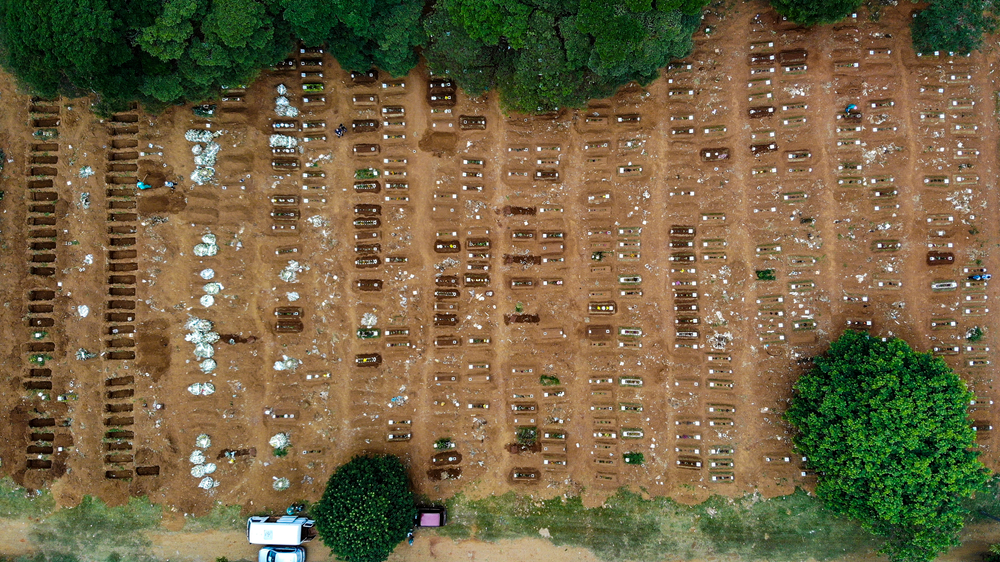
Figure 17; depicting a mass grave in Sao Paulo
3.3 COVID-19 Government Response Stringency Index
The Government Response Stringency Index [75] is a tool to track and compare policy responses to the COVID-19 outbreak. An additive score on nine indicators on a scale from 0 to 100 reflects the level/degree of government response. The index includes indicators such as workplace closures, the cancellation of public events, restrictions on gathering, closure of public transport, public information campaigns, international travel controls, testing policy, etc.
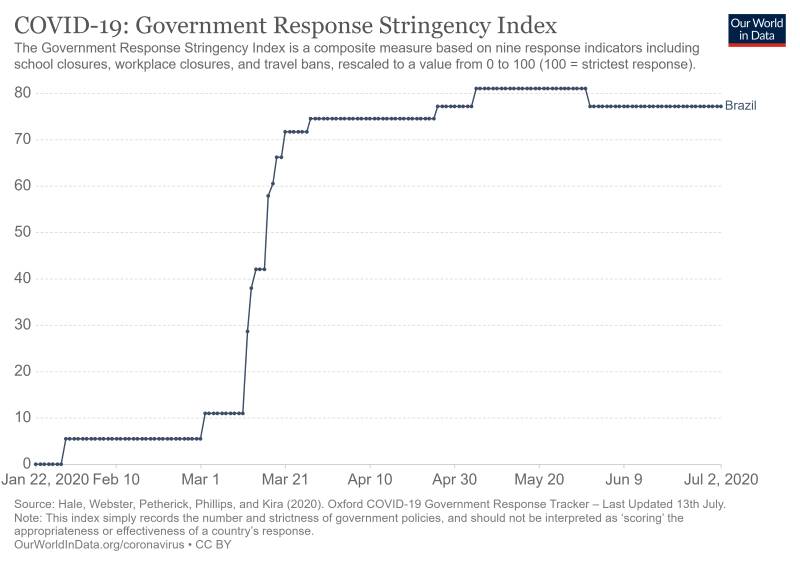
Figure 18; Brazil in the GSRI isolated
Brazil’s policy response to the COVID-19 outbreak witnessed rapidly increasing strictness in from mid- to end-March as federal states imposed social distancing concepts and quarantines. Thereafter, responses stood more or less stable throughout April until in May until the start of June there were even stricter measures. July saw some minor relaxations.
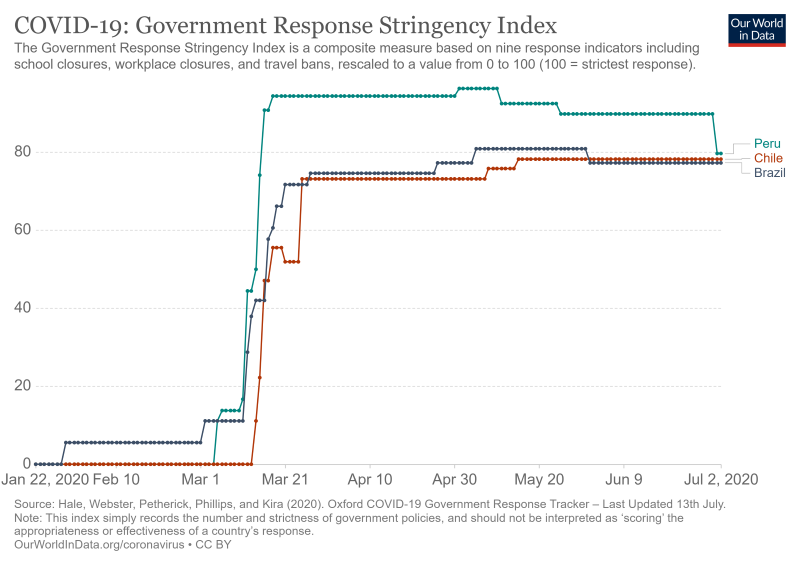
Figure 19; Brazil's Comparative Index Score
In comparative continental perspective, Chile and Peru, which by July 2020 were also under the six most affected countries, both had some varying degree to Brazil in their lockdown-strictness. Peru started not much later than Brazil introducing measures but then went much faster to a deeper lockdown level, reaching an overall score of 94.4 on March 18. Peru held a similar level but eventually, after small relaxations, converged to the Brazilian and Chilean score in July. Chile had almost constantly a score below Brazil until June when it started to be slightly more restrictive.
Yet, there are some major drawbacks to the index that also play out for Brazil. A higher score does not equate to a country being more effective in response to the virus. In the Brazilian case this note is especially important, as I mentioned already that for Sao Paulo, although measures were in place, social adherence was low. In general, compliance is an issue in countries which contain large populations from informal employment. As the implementation aspect is not covered the meaningfulness of the index is restricted.
3.4 Politicization of the COVID-19 crisis & role of president Bolsonaro
Amid the severity of the COVID-19 outbreak in Brazil the country faces a multifaceted political crisis including calls for the impeachment of the president, disputes between federal and regional levels of governments on restrictive measures for virus containment, investigations on president's alleged corruptive behavior and the resignation of several key cabinet members. Some observers refer to the current situation as the most critical crisis in the last decades of Brazilian history [76] .
Brazil's President Bolsonaro has played a particular controversial role in Brazil's handling of the coronavirus outbreak and is at the center of political affairs since the country's first official case. While South American governments reacted quickly in adopting rigorous measures after their first cases, it is commonly viewed that the Brazilian President failed to issue a unitary response. Finally, state governors seized anti-corona measures corresponding to WHO guidelines [77] . Bolsonary stressed repeatedly, that his primary interest lies in not weakening the economy stating that the effects of the lockdown are worst than the outbreak itself and that "some people will die, that's life" [78] . President Bolsonaro does not regard the crisis triggered by the Covid-19 pandemic as a public health or safety crisis, but (only) as a threat that could trigger an economic recession [79]
Bolsonaro has been partly accounted for the country's pandemic development as it displays the worst in Latin America [80] .
Using the analysis of newspaper articles from Frankfurter Allgemeine Zeitung and Süddeutsche Zeitung along with some external sources, I try to provide a chronological overview of the events concerning Bolsonaro's controversial behavior and the political processes related to the current Brazilian governmental and political crisis (as opposed to the former section dealing exclusively with the policy response to its health crisis).
In early March, after referring to the virus as a fantasy exaggerated by the media Bolsonaro's press secretary Fábio Wajngarten and other members of his delegation joining him on his US visit were diagnosed positively on the coronavirus [81] . A test conducted on Bolsonaro returned negative. Afterwards however, Bolsonaro did not follow his prescribed self-quarantine showing in public shaking hands in a public gathering not wearing a mask and defying his own health ministriy's advice [82] . According to some sources Bolsonaro shook hands of 272 people attending the event [83] . Bolsonaro's COVID-19 carelessness continued as he addressed the pandemic as "hysteria" [84] and referred to it as a "gripezinha" (small flu) in a TV speech on March 24th. On the same occasion, Bolsonaro called on governors to withdraw from measures and restrictions so that the economy is not damaged and unemployement is prevented. Meanwhile, protests against the President's trivilializations were held in many major cities by beating on pots and pans in front of open windows and balconies. First calls on impeachement were raised [85] .
At the end of March, the President's handling of the pandemic had already turned into a political power struggle with the state's governors, which had implemented strict quarantine measures and the health ministry, urging for extended action. Congress and the Supreme Court further condemned the President's conduct disregarding the Health Ministry's recommendations in statements [86] .
Although criticism issued against his crisis management rose continuously, the Brazilian government launched a "Brazil cannot stop"-campaign (#BrasilNãoPodeParar) on social media (25th of March), contradicting the decisions from health authorities, as well as state and city governments to prevent COVID-19 from spreading [87] . Barely two days after, a court ruled that the campaign must be taken down. Social media companies were also strongly reacting to Bolsonaro spreading disinformation regarding the coronavirus as both Facebook and Twitter deleted content from official Bolsonaro accounts. In the Twitter case, two videos showing the President disregarding isolation measures were taken down, Facebook deleted a video of Bolsonaro praising Hydroxychloroquin as a remedy for disinformation. Bolsonaro pushed for a release of the drug and ordered its increased production by the army [88] [89] . Resistance came further from civilian society as groups filed an open letter addressing the population not to follow Bolsonaros's campaigns. Moreover, a federal court ruled a ban on the government to initiate measures contradicting the WHO's recommendations for isolation (ibid.). This prohibition invalidated a decree issued by Bolso in which he declared churches to be "essential institutions" that could not be closed. Media further reported on building tensions within the government between Bolsonaro and his health minister Luis Henrique Mandetta, who stood for following WHO guidelines and favoring isolation measures, ultimately leading to his dismissal after weeks of heavy arguments on the 15th of April [90] . Mandetta was widely regarded as popular figure in Bolsonaro's cabinet and called a "voice of reason" for his science-based approach[91] [92] . He was replaced by Nelson Teich who stepped down after a disagreement with Bolsonaro on the release and use of Chloroquine after less than a month. Upon then, the Health Ministry was continued being led by a general without any medical education or background [93] .
As states and cities at the brink of the pandemic were converting football arenas and exhibition centers to hospitals, Bolsonaro pushed for a restart of the national football division [94] . First COVID-19 infections in the extremely densely populated favelas were reported at the end of March in Rio de Janeiro, where media reports focused on organized crime gangs supporting the state government in imposing and enforcing curfews [95] .
Clashes over how to respond to the coronavirus crisis between the country's political leader and influential state governors were further driven to an escalation in April. After publicly criticizing Bolsonaro ("Are you prepared to sign the death certificates of Brazilians? You who defend openness, who minimizes the situation we are in, are you going to bury the victims?”), the governor of Brazil's largest and wealthiest state, São Paulo, João Doria received death threats. As the country found itself in an "almost nation-wide" lockdown, Bolsonaro was calling governors "job killers" [96] . Facing opposition by the most important governors in a federal country, since they were supporting social isolation, and after releasing the health minister who had large approval ratings, this situation was seen as a "critical moment" during Brazil's coronacrisis (ibid.).
However, Bolsonaro resumed his provocative behavior attending an anti-democratic rally in front of the Brazilian army headquarter in Brazilia at the end of April. There, calls were made for and active intervention of the military to end isolation measures in Brazil's states, the closure of congress and the supreme court [97] . As Brazil discussed the possibility of a military coup, analysts named the battle against COVID-19 an "ideological battle" highlighting the far-reaching politicization of the crisis [98] . Bolsonaro's appearance, tolerating demands for a military step in, was sharply criticized by a judge from the supreme court and the president of the chamber of deputies.
Another key event worsening the political crisis in Brazil amid its coronavirus outbreak and the surprise resignation of the minister of justice, Sergío Moro, accompanied by sharp allegations on the President for inappropriately interfering with the work of the feral police. Previously, the triggering event for Moro's decision, Bolsonaro had dismissed the federal police chief that was leading investigations into his personal surroundings including his own son for launching hate campaigns and fake news in social media. Moro, a "star justice minister" and one of the most popular figures in Bolsonaro's administration, becoming famous for leading the “Car Wash” corruption investigation and jailing of former president Luiz Inácio Lula da Silva ahead of the 2018 presidential election [99] , further accused him of dismissing the federal police chief out of political and personal motives. Thereafter, Brazil’s attorney general opened a criminal investigation into Moro’s claims of political interference, which could lead to charges of obstruction of justice and abuse of power on Bolsonaro and pave the way to the president’s impeachment [100]
The crisis grew deeper as protests erupted after the resignation of Moro and the dissolution of the government and as numerous applications for impeachment reaching congress and the Supreme Court investigating against him further weakened Bolsonaro's stand [101] .
Despite this loss of reputation, Bolsonaro's supporters stood at around 30% with reports estimating that the situation is not yet threatening for the president's office, still having the military and evangelicals supporting him [102] . The country's numerous employees from the informal sector, comprising those who cannot afford to stay at home, constitute another important basis on the president's resilience as they favor a "back-to-business" approach on reopening. More on Bolsonaro's approval and Brazilian crisis-management satisfaction is covered in "Legitimacy". In assessments of the Bertelsmann Transformation Index (BTI) covering the quality of democracy, Brazil was situated among those whose democracy has been considerably weakened in the coronacrisis [103]
In spite of Bolsonaro's desire for an urgent end of lockdown measures, at the beginning of May most governors announced extensions of curfews and closures of public places. Meanwhile, Bolsonaro attacked the WHO with provocative remarks [104] and declared gyms and beauty salons as "essential services" that can stay open through the new coronavirus outbreak in a presidential decree. Eventually, the list of essential services also included churches that were permitted on remaining to hold services and religious assemblies with observers stating that Bolsonaro subjected "public health policies to political ties with some evangelical churches with great damage to the health of Brazilians” [105] . Bolsonaro's attempt to install an associate on the office of the chief of the federal police was blocked by the Supreme Court. Bolsonaro's stay in power was at this point characterized as splitting the population. While Brazil's health system was already under severe pressure with especially the Amazon region and Manaus undergoing chaotic conditions and with the "panelaços" (balcony and window protest) constantly taking place, Luis Henrique Mandetta's successor as health minister, Nelson Teich, quit office after just serving for 29 over a disagreement with Bolsonaro on the release use of chloroquine. The Health Ministry was later transferred to a general without prior experience in the area [106] .
At the end of May, South America, with Brazil at its core, developed into the new worldwide epicenter of the coronavirus outbreak [107] . However, limited testing only allowed a glance on real conditions, at this point numbers could have been as much as 15x times higher than officially know. Meanwhile, a video of a cabinet meeting on April 22nd became public, in which Bolsonaro demands the arming of the population against the health protection policies in the federal states and calls governors of the states Sao Paolo and Rio "pieces of shit". In the same session, the Minister of the Environment proposes the deregulation of environmental protection as long as the Corona crisis attracts attention [108] . By then, there were 36 applications calling for the impeachment of Bolsonaro, yet the quorum lying at 342 of 513, there are some considerable constitutional burdens for initiation. Regardless of Bolsonaro's questioning of the country's division of powers, in an interview, the deputy chamber's president Maia yet refused to initiate the procedure justifying the move by pointing at the upcoming economic crisis and the ongoing health crisis [109]
At the beginning of June, Bolsonaro supporters clashed with opposing organized football fans on Brazil's streets further displaying the country's political polarization. While political and legal pressure from Brazil's legislative and judicative democratic institutions on Bolsonaro increased, furthering the country's institutional crisis, concerns about a military intervention were voiced more and more often. A judge from the Supreme Court even drew comparisons of Brazil's situation to the destruction of democracy in the Weimarer Republik [110] . Insiders separate protests around a dissatisfaction on the government's handling of the health crisis from events confronting the country's political democratic institutions, which Bolsonaro's followers oppose for their checks-and-balances capabilities, restricting the president's scope in numerous occasions [111] . In reaction to raids on key supporters of Bolsonaro for forming a fake news network that is supposed to systematically launch false information on opponents of the president, issued by the federal police and authorized by the Supreme Court [112] , rhetoric radicalized to a new extent with Brazil's ministry of education calling the action the "Brazilian Kristallnacht". June 5th, echoing the US decision and while Brazil became one of the pandemic hotspots (counting almost 700.000 cases), Bolsonaro threatened Brazil's withdrawal from the WHO on CNN Brazil stating that "We do not need any people from outside to give us tips about health here." [113] . Although Brazil presented already the third-highest caseload, the combat of the health crisis appeared to have shifted to the field of statistics, as the government ordered first that the presentation of numbers should take place after the big newscasts of the day instead of in the afternoon, then banning figures such as total cases and deaths from the Health Ministry's official website only reporting on newly confirmed cases [114] . Critics accused Bolsonaro's government of systematically complicating coverage and trying to hide the true extent of the pandemic [115] . Yet again the country's trial of strength between the institutions of government, the judiciary and Congress (considering the option of an impeachment) intensified, after the Supreme Court's ruling that full numbers must be republished on June 8th. The government crisis management continued thereafter triggering numerous and large demonstrations around the country. The same week the country topped, as the second internationally, a million cases an installation of a symbolic graveyard in remembrance of the pandemic related deaths, on Copacabana beach as a protest action against the governments' policies received notable media attention when a man knocked over the crosses provoking the emotional reaction of another civilian having previously lost his son to the virus [116] [117] . (BILD)
A court decision, ordering Bolsonaro to wear a mask in public after him openly neglecting the command of Brazil's federal district as an act of rebellion against the "establishment" [118] was later overruled with the argument that the general rule to wear protective masks that had been already in place also applied to the President [119] .
After showing symptoms such as fever and speculation about his health condition, Bolsonaro confirmed his very own COVID-19 infection on July 7th after testing positive for the virus [120] . He also confirmed facing his infection with the treatment of Hydroxychloroquine which he had previously stepped up in the production of the military. Despite of many hopes among Brazil's society that the infection of the President, and consequently him undergoing its effects, could lead to changes in his crisis management approach, Bolsonaro strives to perform as a self-display on what he finds a supposedly overestimated disease. In addition, concerns pointing in the same direction were put forward that Bolsonaro could use his possibly mild course of the disease as a potential instrumentalization of the benefits of Hydroxychloroquine, whose production was upped by the military by the decision of Bolsonaro [121] . Bolsonaro is 65 and is therefore, when opposed to the virus, among its risk group [122] . On July 7th, Bolsonaro entered the statistic as one of ca. 45 000 officially reported infections.
Brazil's President Bolsonaro has played a particular controversial role in Brazil's handling of the coronavirus outbreak and is at the center of political affairs since the country's first official case. While South American governments reacted quickly in adopting rigorous measures after their first cases, it is commonly viewed that the Brazilian President failed to issue a unitary response. Finally, state governors seized anti-corona measures corresponding to WHO guidelines [77] . Bolsonary stressed repeatedly, that his primary interest lies in not weakening the economy stating that the effects of the lockdown are worst than the outbreak itself and that "some people will die, that's life" [78] . President Bolsonaro does not regard the crisis triggered by the Covid-19 pandemic as a public health or safety crisis, but (only) as a threat that could trigger an economic recession [79]
Bolsonaro has been partly accounted for the country's pandemic development as it displays the worst in Latin America [80] .
Using the analysis of newspaper articles from Frankfurter Allgemeine Zeitung and Süddeutsche Zeitung along with some external sources, I try to provide a chronological overview of the events concerning Bolsonaro's controversial behavior and the political processes related to the current Brazilian governmental and political crisis (as opposed to the former section dealing exclusively with the policy response to its health crisis).
In early March, after referring to the virus as a fantasy exaggerated by the media Bolsonaro's press secretary Fábio Wajngarten and other members of his delegation joining him on his US visit were diagnosed positively on the coronavirus [81] . A test conducted on Bolsonaro returned negative. Afterwards however, Bolsonaro did not follow his prescribed self-quarantine showing in public shaking hands in a public gathering not wearing a mask and defying his own health ministriy's advice [82] . According to some sources Bolsonaro shook hands of 272 people attending the event [83] . Bolsonaro's COVID-19 carelessness continued as he addressed the pandemic as "hysteria" [84] and referred to it as a "gripezinha" (small flu) in a TV speech on March 24th. On the same occasion, Bolsonaro called on governors to withdraw from measures and restrictions so that the economy is not damaged and unemployement is prevented. Meanwhile, protests against the President's trivilializations were held in many major cities by beating on pots and pans in front of open windows and balconies. First calls on impeachement were raised [85] .
At the end of March, the President's handling of the pandemic had already turned into a political power struggle with the state's governors, which had implemented strict quarantine measures and the health ministry, urging for extended action. Congress and the Supreme Court further condemned the President's conduct disregarding the Health Ministry's recommendations in statements [86] .
Although criticism issued against his crisis management rose continuously, the Brazilian government launched a "Brazil cannot stop"-campaign (#BrasilNãoPodeParar) on social media (25th of March), contradicting the decisions from health authorities, as well as state and city governments to prevent COVID-19 from spreading [87] . Barely two days after, a court ruled that the campaign must be taken down. Social media companies were also strongly reacting to Bolsonaro spreading disinformation regarding the coronavirus as both Facebook and Twitter deleted content from official Bolsonaro accounts. In the Twitter case, two videos showing the President disregarding isolation measures were taken down, Facebook deleted a video of Bolsonaro praising Hydroxychloroquin as a remedy for disinformation. Bolsonaro pushed for a release of the drug and ordered its increased production by the army [88] [89] . Resistance came further from civilian society as groups filed an open letter addressing the population not to follow Bolsonaros's campaigns. Moreover, a federal court ruled a ban on the government to initiate measures contradicting the WHO's recommendations for isolation (ibid.). This prohibition invalidated a decree issued by Bolso in which he declared churches to be "essential institutions" that could not be closed. Media further reported on building tensions within the government between Bolsonaro and his health minister Luis Henrique Mandetta, who stood for following WHO guidelines and favoring isolation measures, ultimately leading to his dismissal after weeks of heavy arguments on the 15th of April [90] . Mandetta was widely regarded as popular figure in Bolsonaro's cabinet and called a "voice of reason" for his science-based approach[91] [92] . He was replaced by Nelson Teich who stepped down after a disagreement with Bolsonaro on the release and use of Chloroquine after less than a month. Upon then, the Health Ministry was continued being led by a general without any medical education or background [93] .
As states and cities at the brink of the pandemic were converting football arenas and exhibition centers to hospitals, Bolsonaro pushed for a restart of the national football division [94] . First COVID-19 infections in the extremely densely populated favelas were reported at the end of March in Rio de Janeiro, where media reports focused on organized crime gangs supporting the state government in imposing and enforcing curfews [95] .
Clashes over how to respond to the coronavirus crisis between the country's political leader and influential state governors were further driven to an escalation in April. After publicly criticizing Bolsonaro ("Are you prepared to sign the death certificates of Brazilians? You who defend openness, who minimizes the situation we are in, are you going to bury the victims?”), the governor of Brazil's largest and wealthiest state, São Paulo, João Doria received death threats. As the country found itself in an "almost nation-wide" lockdown, Bolsonaro was calling governors "job killers" [96] . Facing opposition by the most important governors in a federal country, since they were supporting social isolation, and after releasing the health minister who had large approval ratings, this situation was seen as a "critical moment" during Brazil's coronacrisis (ibid.).
However, Bolsonaro resumed his provocative behavior attending an anti-democratic rally in front of the Brazilian army headquarter in Brazilia at the end of April. There, calls were made for and active intervention of the military to end isolation measures in Brazil's states, the closure of congress and the supreme court [97] . As Brazil discussed the possibility of a military coup, analysts named the battle against COVID-19 an "ideological battle" highlighting the far-reaching politicization of the crisis [98] . Bolsonaro's appearance, tolerating demands for a military step in, was sharply criticized by a judge from the supreme court and the president of the chamber of deputies.
Another key event worsening the political crisis in Brazil amid its coronavirus outbreak and the surprise resignation of the minister of justice, Sergío Moro, accompanied by sharp allegations on the President for inappropriately interfering with the work of the feral police. Previously, the triggering event for Moro's decision, Bolsonaro had dismissed the federal police chief that was leading investigations into his personal surroundings including his own son for launching hate campaigns and fake news in social media. Moro, a "star justice minister" and one of the most popular figures in Bolsonaro's administration, becoming famous for leading the “Car Wash” corruption investigation and jailing of former president Luiz Inácio Lula da Silva ahead of the 2018 presidential election [99] , further accused him of dismissing the federal police chief out of political and personal motives. Thereafter, Brazil’s attorney general opened a criminal investigation into Moro’s claims of political interference, which could lead to charges of obstruction of justice and abuse of power on Bolsonaro and pave the way to the president’s impeachment [100]
The crisis grew deeper as protests erupted after the resignation of Moro and the dissolution of the government and as numerous applications for impeachment reaching congress and the Supreme Court investigating against him further weakened Bolsonaro's stand [101] .
Despite this loss of reputation, Bolsonaro's supporters stood at around 30% with reports estimating that the situation is not yet threatening for the president's office, still having the military and evangelicals supporting him [102] . The country's numerous employees from the informal sector, comprising those who cannot afford to stay at home, constitute another important basis on the president's resilience as they favor a "back-to-business" approach on reopening. More on Bolsonaro's approval and Brazilian crisis-management satisfaction is covered in "Legitimacy". In assessments of the Bertelsmann Transformation Index (BTI) covering the quality of democracy, Brazil was situated among those whose democracy has been considerably weakened in the coronacrisis [103]
In spite of Bolsonaro's desire for an urgent end of lockdown measures, at the beginning of May most governors announced extensions of curfews and closures of public places. Meanwhile, Bolsonaro attacked the WHO with provocative remarks [104] and declared gyms and beauty salons as "essential services" that can stay open through the new coronavirus outbreak in a presidential decree. Eventually, the list of essential services also included churches that were permitted on remaining to hold services and religious assemblies with observers stating that Bolsonaro subjected "public health policies to political ties with some evangelical churches with great damage to the health of Brazilians” [105] . Bolsonaro's attempt to install an associate on the office of the chief of the federal police was blocked by the Supreme Court. Bolsonaro's stay in power was at this point characterized as splitting the population. While Brazil's health system was already under severe pressure with especially the Amazon region and Manaus undergoing chaotic conditions and with the "panelaços" (balcony and window protest) constantly taking place, Luis Henrique Mandetta's successor as health minister, Nelson Teich, quit office after just serving for 29 over a disagreement with Bolsonaro on the release use of chloroquine. The Health Ministry was later transferred to a general without prior experience in the area [106] .
At the end of May, South America, with Brazil at its core, developed into the new worldwide epicenter of the coronavirus outbreak [107] . However, limited testing only allowed a glance on real conditions, at this point numbers could have been as much as 15x times higher than officially know. Meanwhile, a video of a cabinet meeting on April 22nd became public, in which Bolsonaro demands the arming of the population against the health protection policies in the federal states and calls governors of the states Sao Paolo and Rio "pieces of shit". In the same session, the Minister of the Environment proposes the deregulation of environmental protection as long as the Corona crisis attracts attention [108] . By then, there were 36 applications calling for the impeachment of Bolsonaro, yet the quorum lying at 342 of 513, there are some considerable constitutional burdens for initiation. Regardless of Bolsonaro's questioning of the country's division of powers, in an interview, the deputy chamber's president Maia yet refused to initiate the procedure justifying the move by pointing at the upcoming economic crisis and the ongoing health crisis [109]
At the beginning of June, Bolsonaro supporters clashed with opposing organized football fans on Brazil's streets further displaying the country's political polarization. While political and legal pressure from Brazil's legislative and judicative democratic institutions on Bolsonaro increased, furthering the country's institutional crisis, concerns about a military intervention were voiced more and more often. A judge from the Supreme Court even drew comparisons of Brazil's situation to the destruction of democracy in the Weimarer Republik [110] . Insiders separate protests around a dissatisfaction on the government's handling of the health crisis from events confronting the country's political democratic institutions, which Bolsonaro's followers oppose for their checks-and-balances capabilities, restricting the president's scope in numerous occasions [111] . In reaction to raids on key supporters of Bolsonaro for forming a fake news network that is supposed to systematically launch false information on opponents of the president, issued by the federal police and authorized by the Supreme Court [112] , rhetoric radicalized to a new extent with Brazil's ministry of education calling the action the "Brazilian Kristallnacht". June 5th, echoing the US decision and while Brazil became one of the pandemic hotspots (counting almost 700.000 cases), Bolsonaro threatened Brazil's withdrawal from the WHO on CNN Brazil stating that "We do not need any people from outside to give us tips about health here." [113] . Although Brazil presented already the third-highest caseload, the combat of the health crisis appeared to have shifted to the field of statistics, as the government ordered first that the presentation of numbers should take place after the big newscasts of the day instead of in the afternoon, then banning figures such as total cases and deaths from the Health Ministry's official website only reporting on newly confirmed cases [114] . Critics accused Bolsonaro's government of systematically complicating coverage and trying to hide the true extent of the pandemic [115] . Yet again the country's trial of strength between the institutions of government, the judiciary and Congress (considering the option of an impeachment) intensified, after the Supreme Court's ruling that full numbers must be republished on June 8th. The government crisis management continued thereafter triggering numerous and large demonstrations around the country. The same week the country topped, as the second internationally, a million cases an installation of a symbolic graveyard in remembrance of the pandemic related deaths, on Copacabana beach as a protest action against the governments' policies received notable media attention when a man knocked over the crosses provoking the emotional reaction of another civilian having previously lost his son to the virus [116] [117] . (BILD)
A court decision, ordering Bolsonaro to wear a mask in public after him openly neglecting the command of Brazil's federal district as an act of rebellion against the "establishment" [118] was later overruled with the argument that the general rule to wear protective masks that had been already in place also applied to the President [119] .
After showing symptoms such as fever and speculation about his health condition, Bolsonaro confirmed his very own COVID-19 infection on July 7th after testing positive for the virus [120] . He also confirmed facing his infection with the treatment of Hydroxychloroquine which he had previously stepped up in the production of the military. Despite of many hopes among Brazil's society that the infection of the President, and consequently him undergoing its effects, could lead to changes in his crisis management approach, Bolsonaro strives to perform as a self-display on what he finds a supposedly overestimated disease. In addition, concerns pointing in the same direction were put forward that Bolsonaro could use his possibly mild course of the disease as a potential instrumentalization of the benefits of Hydroxychloroquine, whose production was upped by the military by the decision of Bolsonaro [121] . Bolsonaro is 65 and is therefore, when opposed to the virus, among its risk group [122] . On July 7th, Bolsonaro entered the statistic as one of ca. 45 000 officially reported infections.
3.5 Summary: How the pandemic turned political in Brazil
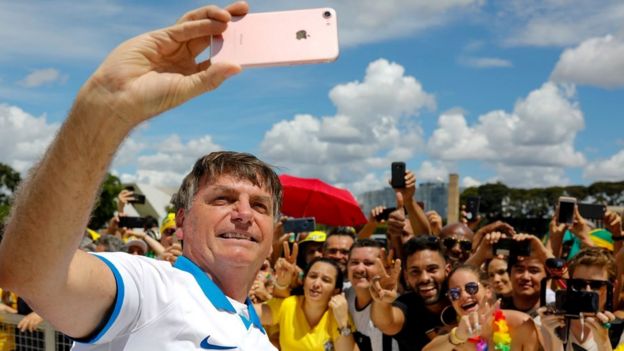
Figure 20; Jair Bolsonaro taking a selfie with supporters; Source: https://www.bbc.com/news/world-latin-america-51955679, accessed 1st July 2020
Despite uninterruptedly rising to the premier positions of the international coronavirus statistics, eventually reaching the second-highest death toll and total numbers behind the US, Brazil's executive leader Jair Messias Bolsonaro, himself among the virus risk-group, regularly trivialized on the virus' threat and demonstrated his carelessness. Given that the real picture is assumed to be even grimmer, as insufficient testing is carried out, Bolsonaro's conduct and actions on behalf of the pandemic spread can be called ignorant at best.
Initially, Bolsonaro, an ultra-right-wing former military member, accused the media of hysteria in their coronavirus-related coverage and named COVID-19 a "small flu" (grippezinha, which has sort of went into a saying when referring to Bolsonaro's crisis management). Disputes with the sub-federal levels of government adopting rigorous confinement measures were triggered as Bolsonaro consistently criticized lockdown measures asking people to disobey their governors and urged for rapid reopening. In April, confronted with the issue that Brazil overtook China's death toll, he responded "so what?" [123] revealing his irresponsible attitude in a nutshell. Bolsonaro's provocative statements came along his regular appearance in gatherings without wearing a mask, shooting selfies with his followers (as depicted in Figure ?) and shaking hands.
Bolsonaro's cabinet dissolved partly as a result of disagreement on the country's strategy in fighting the pandemic. The administration's ex-health minister Mandetta argued publicly for a scientific-based, nationwide response to the epidemic, following examples of previously hit European and Asian states as well as WHO consultations. Another crucial issue of the internal governmental struggle centered around Bolsonaro's support of the use of Chloroquine, a medicine previously used in malaria treatment, but without robust evidence to assist with COVID-19. Throughout the pandemic, Brazil (yet!) saw three different health ministers over barely two months, with a general (Eduardo Pazuello) currently serving on the seat without any medical background.
All throughout the last months, conflicts between the country's major democratic institutions (particularly the Supreme Court and the National Congress against the federal state) arose further complicating the already chaotic and unstable scenario the country faces. The somehow unrelated to the coronavirus but yet inseparable political crisis peaked as a key figure of Bolsonaro's cabinet, justice minister Sergío Moro, previously acknowledged being a key investigator on the imprisonment of former Brazilian president Lula da Silva, withdrew from heading the justice ministry. Following harsh allegations from his side on Bolsonaro interfering with the federal policies for political and personal motives (protecting his sons), an investigation was launched which is said to possibly, as a legal foundation, paving the way for impeachment. Tensions between the executive and judiciary are further stated to be high, as investigations of disinformation and intimidation of opponents by his supporters take place. There have been worries of a return of the military dictatorship among society, as Bolsonaro attended rallies demanding the active military intervention and closure of Congress and the Supreme Court. As well, there are concerns on a subtle deconstruction of the division of power and a military takeover as considerable parts of the administration already consists of military associates.
Bolsonaro's actions during the corona pandemic have been commonly defined as a "economy over health"-approach. When states reacted in adopting social distancing strategies, Bolsonaro countered efforts by calling for a quick reopening, emphasizing that the collateral damage to the economy was worse than the effects of the virus itself. However, there is considerable civilian resistance to the government's corona handling with Brazilian's in self isolations protesting from their balconies and open windows, beating pans and pots. Most sources considered Bolsonaro's support at a constant 30% level of votes (being around 55% when assuming office) which he proved to be able to mobilize. His course is considerably supported by those depending on informal employment as lockdown measures impose them on huge economic risks. Polarization rose dramatically over the course of the ongoing pandemic and open clashes between Bolsonaristas and those politically opposed to the president occurred in numerous cities.
As Bolsonaro himself infected with the disease, no learning seems to take place. Rather, he is expected to instrumentalize his very own example as an account for the supposedly unthreatening outbreak and the beneficiary medicational effects of anti-malarian Chloroquine. As BBC (see the latest footnote) puts it "at a time when Brazil needs to be putting all its efforts into fighting the virus, the president has been doing nothing of the sort."
Nevertheless, it must be noted importantly, that the full scope of Bolsonaro's undoubtedly critical actions and to the utmost extent ignorant role in Brazil's coronavirus epidemic (Brazil becoming what is called "the epicenter of the epicenter") must be assessed scientifically. So far, on a comparative basis, one can only say that other Latin American countries, which had acted in what is said to be the golden standard of responses, imposing restrictive measures early on, find themselves within severe outbreaks too. This can partly be attributed to the countries' economic structure, the informal sector playing an undisputed role in most of them. Yet, it can be concluded on Bolsonaro's role, that his actions contradicting the governors' efforts in containing the virus spread had a huge damaging psychological effect, as particularly supporters felt motivated not to obey by the restrictions. Furthermore, it is clearly a governmental failure not to initiate any national-based strategy in fighting the pandemic.
Initially, Bolsonaro, an ultra-right-wing former military member, accused the media of hysteria in their coronavirus-related coverage and named COVID-19 a "small flu" (grippezinha, which has sort of went into a saying when referring to Bolsonaro's crisis management). Disputes with the sub-federal levels of government adopting rigorous confinement measures were triggered as Bolsonaro consistently criticized lockdown measures asking people to disobey their governors and urged for rapid reopening. In April, confronted with the issue that Brazil overtook China's death toll, he responded "so what?" [123] revealing his irresponsible attitude in a nutshell. Bolsonaro's provocative statements came along his regular appearance in gatherings without wearing a mask, shooting selfies with his followers (as depicted in Figure ?) and shaking hands.
Bolsonaro's cabinet dissolved partly as a result of disagreement on the country's strategy in fighting the pandemic. The administration's ex-health minister Mandetta argued publicly for a scientific-based, nationwide response to the epidemic, following examples of previously hit European and Asian states as well as WHO consultations. Another crucial issue of the internal governmental struggle centered around Bolsonaro's support of the use of Chloroquine, a medicine previously used in malaria treatment, but without robust evidence to assist with COVID-19. Throughout the pandemic, Brazil (yet!) saw three different health ministers over barely two months, with a general (Eduardo Pazuello) currently serving on the seat without any medical background.
All throughout the last months, conflicts between the country's major democratic institutions (particularly the Supreme Court and the National Congress against the federal state) arose further complicating the already chaotic and unstable scenario the country faces. The somehow unrelated to the coronavirus but yet inseparable political crisis peaked as a key figure of Bolsonaro's cabinet, justice minister Sergío Moro, previously acknowledged being a key investigator on the imprisonment of former Brazilian president Lula da Silva, withdrew from heading the justice ministry. Following harsh allegations from his side on Bolsonaro interfering with the federal policies for political and personal motives (protecting his sons), an investigation was launched which is said to possibly, as a legal foundation, paving the way for impeachment. Tensions between the executive and judiciary are further stated to be high, as investigations of disinformation and intimidation of opponents by his supporters take place. There have been worries of a return of the military dictatorship among society, as Bolsonaro attended rallies demanding the active military intervention and closure of Congress and the Supreme Court. As well, there are concerns on a subtle deconstruction of the division of power and a military takeover as considerable parts of the administration already consists of military associates.
Bolsonaro's actions during the corona pandemic have been commonly defined as a "economy over health"-approach. When states reacted in adopting social distancing strategies, Bolsonaro countered efforts by calling for a quick reopening, emphasizing that the collateral damage to the economy was worse than the effects of the virus itself. However, there is considerable civilian resistance to the government's corona handling with Brazilian's in self isolations protesting from their balconies and open windows, beating pans and pots. Most sources considered Bolsonaro's support at a constant 30% level of votes (being around 55% when assuming office) which he proved to be able to mobilize. His course is considerably supported by those depending on informal employment as lockdown measures impose them on huge economic risks. Polarization rose dramatically over the course of the ongoing pandemic and open clashes between Bolsonaristas and those politically opposed to the president occurred in numerous cities.
As Bolsonaro himself infected with the disease, no learning seems to take place. Rather, he is expected to instrumentalize his very own example as an account for the supposedly unthreatening outbreak and the beneficiary medicational effects of anti-malarian Chloroquine. As BBC (see the latest footnote) puts it "at a time when Brazil needs to be putting all its efforts into fighting the virus, the president has been doing nothing of the sort."
Nevertheless, it must be noted importantly, that the full scope of Bolsonaro's undoubtedly critical actions and to the utmost extent ignorant role in Brazil's coronavirus epidemic (Brazil becoming what is called "the epicenter of the epicenter") must be assessed scientifically. So far, on a comparative basis, one can only say that other Latin American countries, which had acted in what is said to be the golden standard of responses, imposing restrictive measures early on, find themselves within severe outbreaks too. This can partly be attributed to the countries' economic structure, the informal sector playing an undisputed role in most of them. Yet, it can be concluded on Bolsonaro's role, that his actions contradicting the governors' efforts in containing the virus spread had a huge damaging psychological effect, as particularly supporters felt motivated not to obey by the restrictions. Furthermore, it is clearly a governmental failure not to initiate any national-based strategy in fighting the pandemic.
4 Legitimacy
Brazil's president Jair Bolsonaro was already highly questioned before he assumed office. Huge protests were held ahead of the 2018 election [124] . The crowds were remarkably diverse with women making up the largest group and gathered behind their catchword #EleNão (#nothim).
In the ongoing pandemic, Brazil has newly been the scene of various pro- and anti-government demonstrations over the past months. Most notably were panelaços: Pot-banging protests from balconies and open windows in Brazil's major cities. The protests were held mostly during public presidential announcements and speeches and motivated by his downplaying of the pandemic as well as the governmental actions. However, there were regular anti-lockdown demonstrations as well in support of the president's anti-scientific approach, publicly held Brazil's capital in front of Congress, Presidential Palace and Supreme Court.
Internationally, Bolsonaro's role in Brazil's coronavirus crisis management was at the spotlight of criticism (see for example [125] or [126] ).
The US imposing travel restrictions in May was regarded as a major defeat for Bolsonaro on world stage [127] .
The subsequent chapter on "Legitimacy" will cover
In the ongoing pandemic, Brazil has newly been the scene of various pro- and anti-government demonstrations over the past months. Most notably were panelaços: Pot-banging protests from balconies and open windows in Brazil's major cities. The protests were held mostly during public presidential announcements and speeches and motivated by his downplaying of the pandemic as well as the governmental actions. However, there were regular anti-lockdown demonstrations as well in support of the president's anti-scientific approach, publicly held Brazil's capital in front of Congress, Presidential Palace and Supreme Court.
Internationally, Bolsonaro's role in Brazil's coronavirus crisis management was at the spotlight of criticism (see for example [125] or [126] ).
The US imposing travel restrictions in May was regarded as a major defeat for Bolsonaro on world stage [127] .
The subsequent chapter on "Legitimacy" will cover
4.1 President's popularity
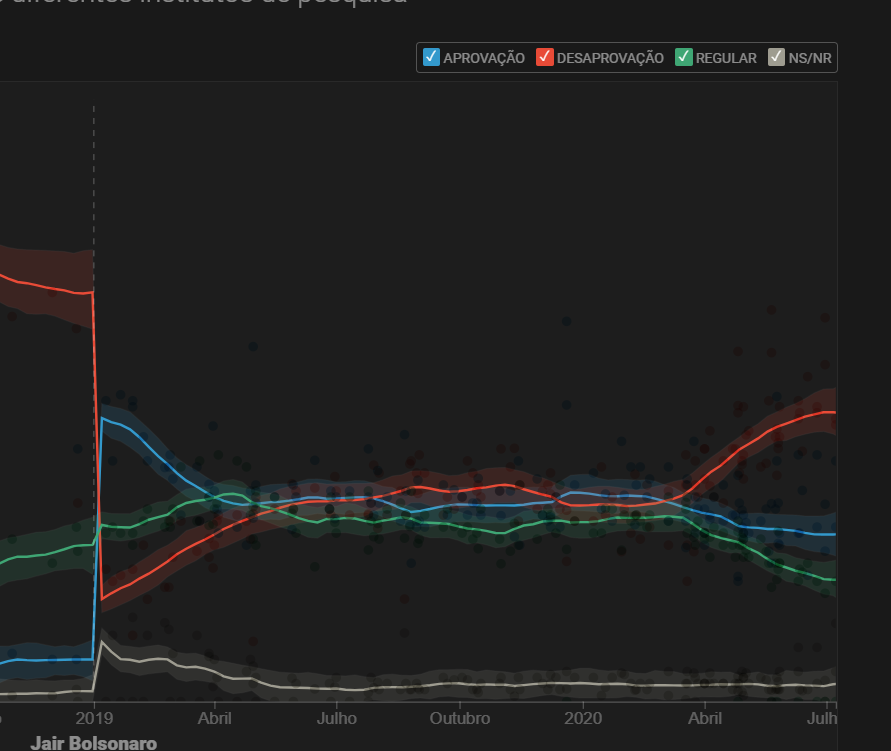
Figure 21; Bolsonaro's Aggregated Approval Ratings since taking office
Jair Bolsonaro won the 2018th election with 55% of the vote.
When it comes to looking at Bolsonaro's popularity, this can prove difficult due to numerous challenges in polling. Therefore, their accuracy and validity are doubtful. I want to point out a few shortcomings: Brazil's data institutes traditionally have difficulties to gain access to a variety of populations (for example in remote areas of the country) and while COVID-19 swept through the country, most polling institutes changed their approach to telephone surveys. Telephone surveys come with the challenge that there is no guarantee of random sampling and considerably less randomization than in face-to-face interviews as many refuse to respond and since telephone lists that are obtained through private business do not feature a representative selection of respondents [128] . According to Lloyd, around 90% of respondents refuse to respond to telephone surveys, while only about 20% refuse to respond to face-to-face interviews. What makes it further hard to assess how popular Bolsonaro is, is the considerable variation in polling results.
Nevertheless, the question of Bolsonaro's approval is not only because of his coronacrisis handling of high matter but also because of the possibility of an impeachment trial and confrontations with the Supreme Court. Therefore one might ask: Is there enough support to sustain him in office?
In a nutshell, it can be stated that Bolsonaro has not received additional support during the pandemic. Unlike other world leaders, there was no bump in popularity as part of a rally-around-the-flag effect. As one can see from aggregated data drawn from Brazilian information institute JOTA [[https://data.jota.info/aprovacao/]], disapproval ratings climbed and approval ratings declined since March (FIGURE 21 ). The aggregator counts ca. 400 polls throughout the country and has predicted the outcome of the 2018th election with 54,8% (as opposed to a final result of 55,1%), predicting closer than any other institute. The dark points in the graph represent polling results. Bolsonaro took office with ca. 50% of approval. Since the pandemic took off, his disapproval reached a height of around 48% of respondents with constant support of ca. 30% of the population. This hints at how polarized the country really is.
When it comes to looking at Bolsonaro's popularity, this can prove difficult due to numerous challenges in polling. Therefore, their accuracy and validity are doubtful. I want to point out a few shortcomings: Brazil's data institutes traditionally have difficulties to gain access to a variety of populations (for example in remote areas of the country) and while COVID-19 swept through the country, most polling institutes changed their approach to telephone surveys. Telephone surveys come with the challenge that there is no guarantee of random sampling and considerably less randomization than in face-to-face interviews as many refuse to respond and since telephone lists that are obtained through private business do not feature a representative selection of respondents [128] . According to Lloyd, around 90% of respondents refuse to respond to telephone surveys, while only about 20% refuse to respond to face-to-face interviews. What makes it further hard to assess how popular Bolsonaro is, is the considerable variation in polling results.
Nevertheless, the question of Bolsonaro's approval is not only because of his coronacrisis handling of high matter but also because of the possibility of an impeachment trial and confrontations with the Supreme Court. Therefore one might ask: Is there enough support to sustain him in office?
In a nutshell, it can be stated that Bolsonaro has not received additional support during the pandemic. Unlike other world leaders, there was no bump in popularity as part of a rally-around-the-flag effect. As one can see from aggregated data drawn from Brazilian information institute JOTA [[https://data.jota.info/aprovacao/]], disapproval ratings climbed and approval ratings declined since March (FIGURE 21 ). The aggregator counts ca. 400 polls throughout the country and has predicted the outcome of the 2018th election with 54,8% (as opposed to a final result of 55,1%), predicting closer than any other institute. The dark points in the graph represent polling results. Bolsonaro took office with ca. 50% of approval. Since the pandemic took off, his disapproval reached a height of around 48% of respondents with constant support of ca. 30% of the population. This hints at how polarized the country really is.
4.2 Support for Democracy
According to Datafolha, a highly respected polling institute belonging to “Grupo Folha” (Brazil’s largest media conglomerate) support for democracy reached 75% in June (respondent: 2.016 23.-24.06.). Despite a political climate in which threats seemed evident, including Bolsonaro’s confrontation with Congress and the Federal Supreme Court and his support of protests in favour of their closure using military force, this is the highest index since 1989 when Datafolha began to assess the data. Those who reject Bolsonaro tended to support democracy more (85%). According to Datafolha, the country is divided between those who see the risk of installing a dictatorship (46%) and those who dismiss this (49%) [129] .
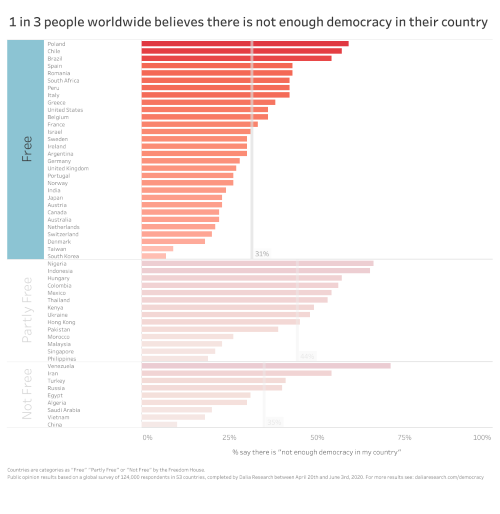
Figure 22, Attitude towards Democracy
The "Democracy Perception Index", conducted by Dalia Research in collaboration with the Alliance of Democracies, monitors attitudes towards democracy from around the world. They claim that "the 2020 edition offers a unique comparison of global public opinion during the COVID-19 crisis". Results are based on nationally representative interviews with 124,000 respondents from 53 countries conducted between April 20th and June 3rd 2020.
The results concerning Brazil are depicted in Figures ?. 54% of Brazilians believe accordingly that there is not enough democracy in their country, in comparison to South Korea with 7% or 30% in Argentina stating the exact same.
The results concerning Brazil are depicted in Figures ?. 54% of Brazilians believe accordingly that there is not enough democracy in their country, in comparison to South Korea with 7% or 30% in Argentina stating the exact same.
4.3 Satisfaction with Federal Government
Figure 23; Government Satisfaction with regard to Coronavirus crisis management 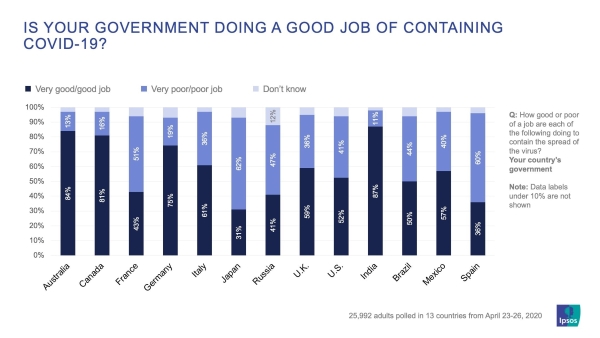 | Figure 24; Results over time 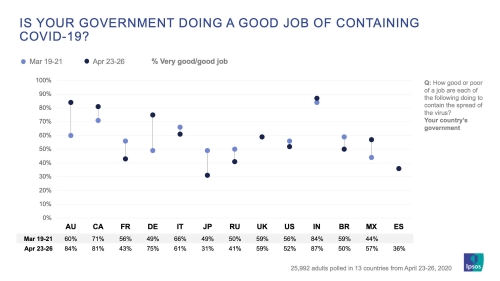 |
Private Research Institute Ipsos examined attitudes towards the national government’s job to contain COVID-19 in April. On the left-hand side, overall satisfaction is depicted with 44% of respondents rating that the federal government did a poor job. Discontent rose in comparison to a formerly conducted survey in March by 9% [130] .
Figure 25 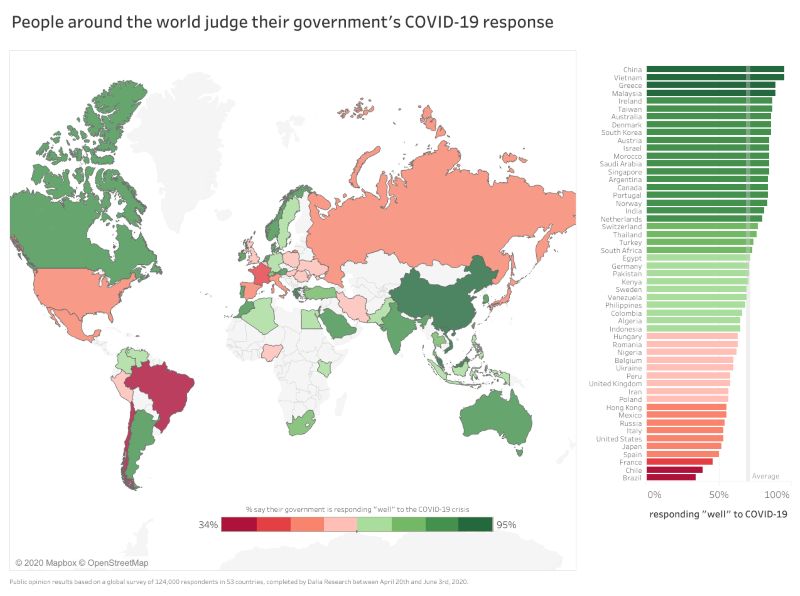 | Figure 27 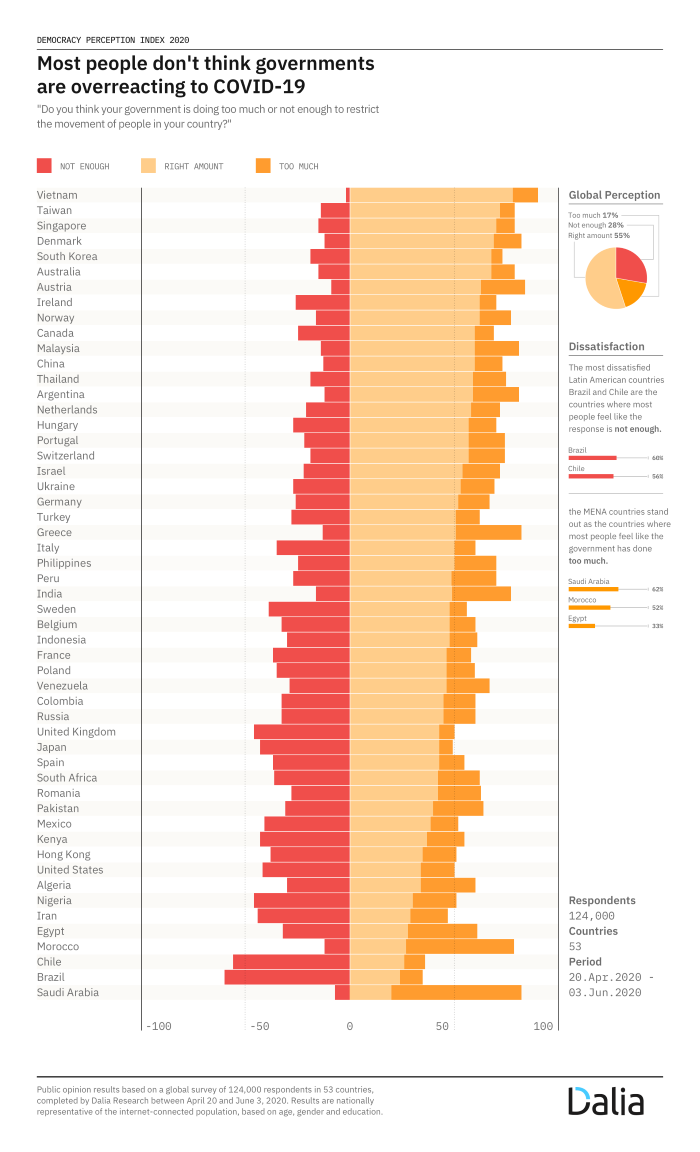 |
From a comparative perspective (Figure 26, 27), Brazil is among the most dissatisfied countries with its COVID-19 response. In the period from 20.04.2020 to 03.06.2020 60% believed that the government was not doing enough addressing COVID-19. Under 50% thought that the governments' measures were the right amount or too much. This further speaks for high levels of discontent among the population. (DALIA SOURCE).
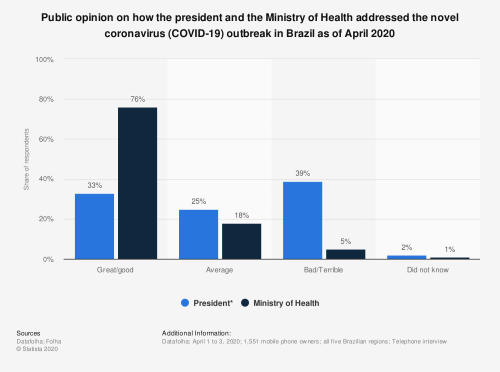 | 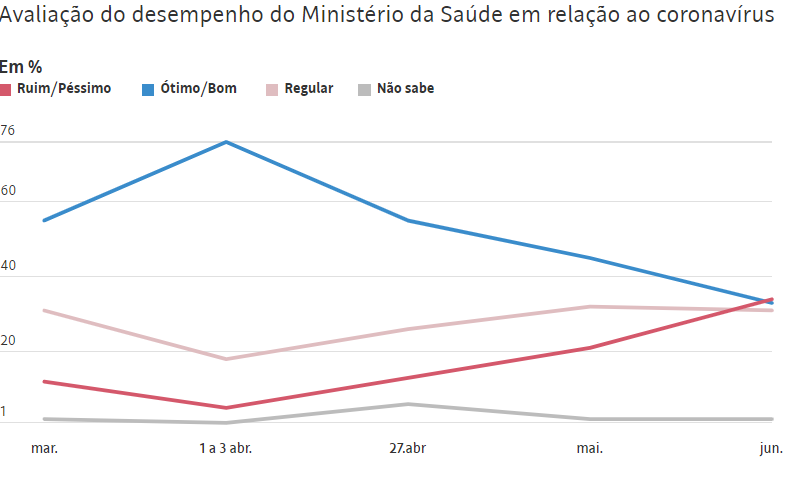 |
The results from Figure ? are interesting as they appear to indicate that the government evaluation was highly dependent on the positive evaluation of the Ministry of Health. Around two-thirds of respondents approved the way the Ministry of Health was dealing with the issue as opposed to only one-third considering the president's handling as great or good. It must be noted, that this survey was conducted before Bolsonaro's dismissal of Health minister Mandetta who was considered a very popular figure in his cabinet pushing to follow the WHO's guidelines.
Assessing the same survey over time (Figure ?), one can derive that after Mandetta's dismissal, the popularity of the Ministry of Health declined dramatically. By June, after another Health Minister stepped down and Eduardo Pazuello, a military general assumed office, public opinion turned. More people had a negative view of the Ministry of Health addressing COVID-19 than positive.
Assessing the same survey over time (Figure ?), one can derive that after Mandetta's dismissal, the popularity of the Ministry of Health declined dramatically. By June, after another Health Minister stepped down and Eduardo Pazuello, a military general assumed office, public opinion turned. More people had a negative view of the Ministry of Health addressing COVID-19 than positive.
4.4 Legitimacy on state-level
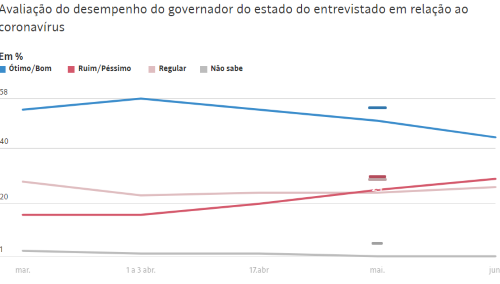
Figure 28; Governor's approval
According to Datafolha (depicted in Figure 28), Brazil's state governors approval were continuously above the 40% mark, yet declining as the pandemic proceeded. Thus for large parts, the states won more approval than Bolsonaro’s government in the fight against the pandemic [131] .
5 Overall evaluation
„This is not just a public health crisis, it is a crisis that will touch every sector – so every sector and every individual must be involved in the fight.
I have said from the beginning that countries must take a whole-of-government, whole-of-society approach, built around a comprehensive strategy to prevent infections, save lives and minimize impact”
These were the word which WHO’s Director-General Tedros Adhanom Ghebreyesus used at the media briefing on COVID-19 on March 11th, 2020. At this day COVID-19 was declared a pandemic[132]
If one evaluates Brazil’s coronavirus response against this statement, one receives a grim picture. Brazil’s pandemic response has arguably been one of the worst in the world. During the outbreak, Brazil moved towards becoming a major epicentre and the second hardest-hit country in the world. It must be noted at all time, that the real picture is expected to look even grimmer since testing is not carried out sufficiently and thus cases are massively undercounted. Brazil’s president was accused of denialism, not taking the threat seriously and has been called the “worst COVID-president” [133] and himself the biggest threat to Brazil’s COVID-19 response.
Brazil's president is accused of constantly downplaying the virus' threat by initially calling reactions "hysteric", the extent of the virus a "fantasy" and COVID-19 itself a "little flu". Bolsonaro ignores the lethality of COVID-19 on Brazilian ground with the argument that "we will all die". He called for lockdown measures imposed by local authorities to be lifted thus undermining local governments' efforts to implement localized quarantine measures. Ultimately, this led to Bolsonaro now being indicted by the International Criminal Court for crimes against humanity Spiegel, Der. 2020. “Bolsonaros Corona-Politik: Gewerkschaften rufen Internationalen Strafgerichtshof an.” DER SPIEGEL, July 27. https://www.spiegel.de/politik/ausland/brasilien-internationaler-strafgerichtshof-wegen-jair-bolsonaros-corona-politik-angerufen-a-f9f6fb71-9d60-4cce-a164-450c8e8e50a8 (Accessed July 30, 2020.354Z).
Despite the undoubted need, It cannot be said that Brazil has a nationally coordinated response to the new Coronavirus. Despite Brazil’s curve not bending, Bolsonaro opposed broad nation-wide lockdowns and argued for vertical isolation (only the old and the vulnerable staying at home) (Pereira, Anthony. 2020-07-10T13:34:57Z. “Brazil's Jair Bolsonaro has coronavirus – what it could mean for him politically.” 2020-07-10T13:34:57Z. https://theconversation.com/brazils-jair-bolsonaro-has-coronavirus-what-it-could-mean-for-him-politically-142232 (July 17, 2020).). Additionally to its uncoordinated coronavirus handling Brazil sees grave political instabilities and conflicts between its main institutions. This is especially critical as Bolsonaro is not known for his strong democratic commitments, stated admiration for the country’s past military dictatorship and because large parts of government and bureaucracy have already been replaced with military associates.
In the middle of a public health emergency, due to the president’s policies, the government has lost two important and influential ministers within 3 weeks. First, on April 16, Luiz Henrique Mandetta, the respected and well-liked Health Minister, was sacked after a television interview, in which he strongly criticised Bolsonaro’s actions and called for unity. On April 24, following the removal of the head of Brazil’s federal police by Bolsonaro, Justice Minister Sérgio Moro, one of the most powerful figures of the right-wing government and appointed by Bolsonaro to combat corruption, announced his resignation. Other areas of concern comprise the environment. As attention shifts, one of the potential areas of increasing vulnerability is deforestation.
As the preparedness section suggested, Brazil’s chronically underfunded health care system SUS could have already been expected to have a tough time handling the influx through COVID-19, further fueling the need of a concentrated and coordinated crisis management. Brazil’s population has been affected disproportionally by the pandemic and its longstanding structural inequalities have been exacerbated. Brazil’s poorest as well as indigenous communities are particularly exposed. There have been what was called “racial undertones of the pandemic” with the black and brown population being more reliant on the overstretched and underfunded public health system [134] .
Indigenous communities are placed at higher risks as they, among other things, living in remote areas of the country face additional barriers to seeking medical care. The Indigenous population has been under severe threat even before the COVID-19 outbreak because the government has been ignoring or even encouraging illegal mining and logging in the Amazon rainforest. The pandemic imposes the country’s indigenous people under existential threat. An open letter on May 3 by a global coalition of artists, celebrities, scientists, and intellectuals, organized by the Brazilian photojournalist Sebastião Salgado, warns of an impending genocide [135] .
The legitimacy section shows, despite critical variations in polling results that Brazilians did not gather behind their leader and that there has been no “integration” of the political landscape in Brazil. Brazil’s 26 states (plus the Federal District) are at the frontline of the defence against the crisis. However, there is evidence that the president's repeated downplaying of the virus’ severity encouraged non-compliance to state-level measures. Recently, governors of Rio and Sao Paulo have been in the spotlight of criticism for opening. Brazil’s two largest cities, Sao Paulo and Rio de Janeiro are in the middle of phased loosening of their lockdowns.
It is likely that Brazil stands in the middle of its worst public health crisis in history and it is likely to have very pessimistic prospects for the future as a global economic recession is widely expected. For Brazil,the IMF has estimated a 5.2% fall in GDP for 2020.
I have said from the beginning that countries must take a whole-of-government, whole-of-society approach, built around a comprehensive strategy to prevent infections, save lives and minimize impact”
These were the word which WHO’s Director-General Tedros Adhanom Ghebreyesus used at the media briefing on COVID-19 on March 11th, 2020. At this day COVID-19 was declared a pandemic[132]
If one evaluates Brazil’s coronavirus response against this statement, one receives a grim picture. Brazil’s pandemic response has arguably been one of the worst in the world. During the outbreak, Brazil moved towards becoming a major epicentre and the second hardest-hit country in the world. It must be noted at all time, that the real picture is expected to look even grimmer since testing is not carried out sufficiently and thus cases are massively undercounted. Brazil’s president was accused of denialism, not taking the threat seriously and has been called the “worst COVID-president” [133] and himself the biggest threat to Brazil’s COVID-19 response.
Brazil's president is accused of constantly downplaying the virus' threat by initially calling reactions "hysteric", the extent of the virus a "fantasy" and COVID-19 itself a "little flu". Bolsonaro ignores the lethality of COVID-19 on Brazilian ground with the argument that "we will all die". He called for lockdown measures imposed by local authorities to be lifted thus undermining local governments' efforts to implement localized quarantine measures. Ultimately, this led to Bolsonaro now being indicted by the International Criminal Court for crimes against humanity Spiegel, Der. 2020. “Bolsonaros Corona-Politik: Gewerkschaften rufen Internationalen Strafgerichtshof an.” DER SPIEGEL, July 27. https://www.spiegel.de/politik/ausland/brasilien-internationaler-strafgerichtshof-wegen-jair-bolsonaros-corona-politik-angerufen-a-f9f6fb71-9d60-4cce-a164-450c8e8e50a8 (Accessed July 30, 2020.354Z).
Despite the undoubted need, It cannot be said that Brazil has a nationally coordinated response to the new Coronavirus. Despite Brazil’s curve not bending, Bolsonaro opposed broad nation-wide lockdowns and argued for vertical isolation (only the old and the vulnerable staying at home) (Pereira, Anthony. 2020-07-10T13:34:57Z. “Brazil's Jair Bolsonaro has coronavirus – what it could mean for him politically.” 2020-07-10T13:34:57Z. https://theconversation.com/brazils-jair-bolsonaro-has-coronavirus-what-it-could-mean-for-him-politically-142232 (July 17, 2020).). Additionally to its uncoordinated coronavirus handling Brazil sees grave political instabilities and conflicts between its main institutions. This is especially critical as Bolsonaro is not known for his strong democratic commitments, stated admiration for the country’s past military dictatorship and because large parts of government and bureaucracy have already been replaced with military associates.
In the middle of a public health emergency, due to the president’s policies, the government has lost two important and influential ministers within 3 weeks. First, on April 16, Luiz Henrique Mandetta, the respected and well-liked Health Minister, was sacked after a television interview, in which he strongly criticised Bolsonaro’s actions and called for unity. On April 24, following the removal of the head of Brazil’s federal police by Bolsonaro, Justice Minister Sérgio Moro, one of the most powerful figures of the right-wing government and appointed by Bolsonaro to combat corruption, announced his resignation. Other areas of concern comprise the environment. As attention shifts, one of the potential areas of increasing vulnerability is deforestation.
As the preparedness section suggested, Brazil’s chronically underfunded health care system SUS could have already been expected to have a tough time handling the influx through COVID-19, further fueling the need of a concentrated and coordinated crisis management. Brazil’s population has been affected disproportionally by the pandemic and its longstanding structural inequalities have been exacerbated. Brazil’s poorest as well as indigenous communities are particularly exposed. There have been what was called “racial undertones of the pandemic” with the black and brown population being more reliant on the overstretched and underfunded public health system [134] .
Indigenous communities are placed at higher risks as they, among other things, living in remote areas of the country face additional barriers to seeking medical care. The Indigenous population has been under severe threat even before the COVID-19 outbreak because the government has been ignoring or even encouraging illegal mining and logging in the Amazon rainforest. The pandemic imposes the country’s indigenous people under existential threat. An open letter on May 3 by a global coalition of artists, celebrities, scientists, and intellectuals, organized by the Brazilian photojournalist Sebastião Salgado, warns of an impending genocide [135] .
The legitimacy section shows, despite critical variations in polling results that Brazilians did not gather behind their leader and that there has been no “integration” of the political landscape in Brazil. Brazil’s 26 states (plus the Federal District) are at the frontline of the defence against the crisis. However, there is evidence that the president's repeated downplaying of the virus’ severity encouraged non-compliance to state-level measures. Recently, governors of Rio and Sao Paulo have been in the spotlight of criticism for opening. Brazil’s two largest cities, Sao Paulo and Rio de Janeiro are in the middle of phased loosening of their lockdowns.
It is likely that Brazil stands in the middle of its worst public health crisis in history and it is likely to have very pessimistic prospects for the future as a global economic recession is widely expected. For Brazil,the IMF has estimated a 5.2% fall in GDP for 2020.
5.1 Further Readings
https://theconversation.com/covid-19-is-deadlier-for-black-brazilians-a-legacy-of-structural-racism-that-dates-back-to-slavery-139430
- This article points out the structural reasons underlying the observation of Black Brazilians dying and infecting at higher rates from COVID-19 than the rest of the population
https://blogs.lse.ac.uk/latamcaribbean/2020/06/03/the-impact-of-covid-19-on-brazils-precarious-labour-market-calls-for-far-reaching-policies-like-universal-basic-income/
- The authors from the London School of Economics suggest a universal basic income to deal with the country's large quantity of economic informality
https://www.nytimes.com/2020/07/15/opinion/coronavirus-covid-brazil-bolsonaro.html?auth=login-google
- A famous Brazilian YouTuber comments on a supposedly direct link between the US November election and Bolsonaro's political future
https://carto.com/blog/covid19-inequality-brazil-coronavirus-maps/
- Several maps depicting the disproportionate impact of COVID-19 in Brazil
- This article points out the structural reasons underlying the observation of Black Brazilians dying and infecting at higher rates from COVID-19 than the rest of the population
https://blogs.lse.ac.uk/latamcaribbean/2020/06/03/the-impact-of-covid-19-on-brazils-precarious-labour-market-calls-for-far-reaching-policies-like-universal-basic-income/
- The authors from the London School of Economics suggest a universal basic income to deal with the country's large quantity of economic informality
https://www.nytimes.com/2020/07/15/opinion/coronavirus-covid-brazil-bolsonaro.html?auth=login-google
- A famous Brazilian YouTuber comments on a supposedly direct link between the US November election and Bolsonaro's political future
https://carto.com/blog/covid19-inequality-brazil-coronavirus-maps/
- Several maps depicting the disproportionate impact of COVID-19 in Brazil
6 Country's favorite stay at home song
Anavitória - Me conta da tua janela
For this section, I relied on information stemming from within the country. A close Brazilian friend from Belo Horizonte recommended this track to me using the words "the name of the song means "tell me about your window". It is about staying at home and the sentimentality that is related". The song ends pathetically: "I made this song, friend" (Eu fiz essa canção, amigo), for the whole world to heal (Pro mundo inteiro se curar)".
For this section, I relied on information stemming from within the country. A close Brazilian friend from Belo Horizonte recommended this track to me using the words "the name of the song means "tell me about your window". It is about staying at home and the sentimentality that is related". The song ends pathetically: "I made this song, friend" (Eu fiz essa canção, amigo), for the whole world to heal (Pro mundo inteiro se curar)".
[1] Gurk, Christoph. 2020. “Sie tanzen und sie sterben.” Süddeutsche Zeitung, June 17, 3.
[2] Charner, Flora. 2020. “Brazil tops 1 million Covid-19 cases. It may pass the US next, becoming the worst-hit country on the planet - CNN.” June 19. https://edition.cnn.com/2020/06/19/americas/brazil-one-million-coronavirus-jair-bolsonaro-cases-intl/index.html (June 23, 2020).
[3] Boin, Arjen, Paul t Hart, Eric Stern, and Bengt Sundelius. 2017. The Politics of Crisis Management. Cambridge: Cambridge University Press.
[4] Encyclopædia Britannica, inc. 2020. “Brazil.” June 22. https://www.britannica.com/place/Brazil (June 23, 2020).
[5] The World Bank. 2019. “World Development Indicators.” December 23. https://datacatalog.worldbank.org/dataset/population-ranking (June 24, 2020).
[6] Bundeszentrale für politische Bildung. 2018. “Brasilien | bpb.” Bundeszentrale für politische Bildung, November 27. https://www.bpb.de/nachschlagen/lexika/fischer-weltalmanach/65645/brasilien?rl=0.4515496048175933 (Accessed June 20, 2020.179Z).
[7] Central Intelligence Agency. 2020. “South America: Brazil — The World Factbook.” June 19. https://www.cia.gov/library/publications/the-world-factbook/geos/br.html (June 30, 2020).
[8] Statista. “G20 - Altersmedian der Bevölkerung in Industrie- und Schwellenländern 2020 | Statista.” https://de.statista.com/statistik/daten/studie/684349/umfrage/altersmedian-der-bevoelkerung-in-g20-staaten/ (June 30, 2020.971Z).
[9] The World Bank. 2020. “Brazil | Data.” https://data.worldbank.org/country/brazil (June 25, 2020).
[10] Gallas, Daniel, and Daniele Palumbo. 2019. “What's gone wrong with Brazil's economy?” BBC News, May 27. https://www.bbc.com/news/business-48386415 (Accessed June 24, 2020).
[11] Dias Carneiro, Júlia. “Jair Bolsonaro: Brazil's unlikely president - BBC News.” https://www.bbc.co.uk/news/resources/idt-sh/Jair_Bolsonaro_Brazil (June 23, 2020).
[12] Carneiro, Dias J. 2019. “Jair Bolsonaro: Brazil's unlikely president - BBC News.” January 9. https://www.bbc.co.uk/news/resources/idt-sh/Jair_Bolsonaro_Brazil (June 23th, 2020).
[13] Brühwiller, Tjerk. 2019. “Bolsonaros Pakt mit den Freikirchen.” Frankfurter Allgemeine Zeitung, December 27. https://www.faz.net/aktuell/politik/ausland/brasilien-jair-bolsonaros-pakt-mit-den-evangelikalen-16547623.html (Accessed May 13, 2020).
[14] Welle, Deutsche. 2020.000Z. “Brazil: Jair Bolsonaro names active-duty general as chief of staff | DW | 13.02.2020.” [en_GB]. Deutsche Welle (www.dw.com). July 10.000Z. https://www.dw.com/en/brazil-jair-bolsonaro-names-active-duty-general-as-chief-of-staff/a-52373488 (July 10, 2020).
[15] Brühwiller, Tjerk. 2020. “Bolsonaro lässt Bananen verteilen.” Frankfurter Allgemeine Zeitung, March 5. https://www.faz.net/aktuell/wirtschaft/brasilien-jair-bolsonaro-laesst-bananen-an-journalisten-verteilen-16665182.html (Accessed July 9, 2020.952Z).)
[16] Brühwiller, Tjerk. 2020. “Brasilien auf der Intensivstation: Brasiliens Wirtschaft wird im besten Fall geschwächt aus der Krise hervorgehen. Investoren ziehen Kapital aus Brasilien ab wie aus keinem anderen Schwellenland.” Frankfurter Allgemeine Zeitung, May 19.
[17] “Brasilien - Bewertung nach dem Fragile States Index (FSI) bis 2020 | Statista.” https://de.statista.com/statistik/daten/studie/954974/umfrage/bewertung-brasiliens-nach-dem-fragile-states-index/#professional (July 18, 2020.763Z).
[18] 2020.000Z. “Pandemic Influenza Preparedness Plan | Strategic Partnership for IHR and Health Security (SPH).” July 1.000Z. https://extranet.who.int/sph/influenza-plan (July 1, 2020).
[19] http://bvsms.saude.gov.br/bvs/publicacoes/guia_vigilancia_epidemiologica_7ed.pdf
[20] Werneck, Guilherme L., and Marilia S. Carvalho. 2020. “A pandemia de COVID-19 no Brasil: crônica de uma crise sanitária anunciada.” [The COVID-19 pandemic in Brazil: chronicle of a health crisis foretold] [eng]. Cadernos de saude publica 36 (5): e00068820.
[21] Rodriguez-Morales, Alfonso J., Viviana Gallego, Juan P. Escalera-Antezana, Claudio A. Méndez, Lysien I. Zambrano, Carlos Franco-Paredes, Jose A. Suárez, Hernan D. Rodriguez-Enciso, Graciela J. Balbin-Ramon, Eduardo Savio-Larriera, Alejandro Risquez, and Sergio Cimerman. 2020. “COVID-19 in Latin America: The implications of the first confirmed case in Brazil.” [eng]. Travel Medicine and Infectious Disease 35: 101613.
[22] Marson, F. L., and M. M. Ortega. 2020. “COVID-19 in Brazil.” [eng]. Pulmonology.
[23] Marson, F. L., and M. M. Ortega. 2020. “COVID-19 in Brazil.” [eng]. Pulmonology.
[24] Brühwiller, Tjerk. 2020. “Das Virus ist nicht gerecht: Ungleichheit und Klassenmedizin: Lateinamerika droht eine Katastrophe.” Frankfurter Allgemeine Zeitung, March 28.
[25] Massuda, Adriano, Thomas Hone, Fernando A. G. Leles, Marcia C. de Castro, and Rifat Atun. 2018. “The Brazilian health system at crossroads: progress, crisis and resilience.” [eng]. BMJ Global
[26] Paim, Jairnilson, Claudia Travassos, Celia Almeida, Ligia Bahia, and James Macinko. 2011. “The Brazilian health system: history, advances, and challenges.” The Lancet 377 (9779): 1778–97.
[27] Montekio, Víctor B., Guadalupe Medina, and Rosana Aquino. 2011. “Sistema de salud de Brasil.”The health system of Brazil] [spa]. Salud publica de Mexico 53 Suppl 2: s120-31.
[28] https://www.statista.com/statistics/1070990/brazil-hospital-beds-penetration/
[29] Barreto, Mauricio L., M. G. Teixeira, Francisco I. Bastos, Ricardo A. A. Ximenes, Rita B. Barata, and Laura C. Rodrigues. 2011. “Successes and failures in the control of infectious diseases in Brazil: social and environmental context, policies, interventions, and research needs.” The Lancet 377 (9780): 1877–89.
[30] Ribeiro, Barbara, Sarah Hartley, Brigitte Nerlich, and Rusi Jaspal. 2018. “Media coverage of the Zika crisis in Brazil: The construction of a ‘war’ frame that masked social and gender inequalities.” Social Science & Medicine 200: 137–44. http://www.sciencedirect.com/science/article/pii/S0277953618300236.Ribeiro, Barbara, Sarah Hartley, Brigitte Nerlich, and Rusi Jaspal. 2018. “Media coverage of the Zika crisis in Brazil: The construction of a ‘war’ frame that masked social and gender inequalities.” Social Science & Medicine 200: 137–44. http://www.sciencedirect.com/science/article/pii/S0277953618300236.
[31] Deisy Ventura, Fernando Aith, and Danielle Rached. 2020. The Emergency of the new Coronavirus and the “Quarantine Law” in Brazil.
[32] 2020. “How much do we know about countries preparedness to respond to pandemics? Insights from two country-level indices.” July 7.000Z. https://www.unsdsn.org/how-much-do-we-know-about-countries-preparedness-to-respond-to-pandemics-insights-from-two-country-level-indices (July 7, 2020).
[33] Global Health Security Index. 2020. “About the GHS Index.” May 6. https://www.ghsindex.org/about/ (June 20, 2020).
[34] 2020. “Pandemic Preparedness Index Unprepared for COVID-19 - knoema.com.” July 7.000Z. https://knoema.de/ybojbie/pandemic-preparedness-index-unprepared-for-covid-19 (July 7, 2020).
[35] 2020. “The U.S. and COVID-19: Leading the World by GHS Index Score, not by Response - GHS Index.” April 27+00:00. https://www.ghsindex.org/news/the-us-and-covid-19-leading-the-world-by-ghs-index-score-not-by-response/ (July 7, 2020).
[36] 2020. “How much do we know about countries preparedness to respond to pandemics? Insights from two country-level indices.” July 7. https://www.unsdsn.org/how-much-do-we-know-about-countries-preparedness-to-respond-to-pandemics-insights-from-two-country-level-indices (July 8, 2020).
[37] 2020. “How much do we know about countries preparedness to respond to pandemics? Insights from two country-level indices.” July 7. https://www.unsdsn.org/how-much-do-we-know-about-countries-preparedness-to-respond-to-pandemics-insights-from-two-country-level-indices (July 8, 2020).
[38] http://analytics.dkv.global/covid-regional-assessment-200-regions/full-report.pdf
[39] http://analytics.dkv.global/covid-regional-assessment-200-regions/full-report.pdf
[40] Rüb, Matthias, and Tjerk Brühwiller. “Wem hilft die „Armee der weißen Kittel“?” Frankfurter Allgemeine Zeitung, March 17. https://www.faz.net/aktuell/gesellschaft/gesundheit/coronavirus/corona-in-italien-fachkraefte-aus-kuba-und-venezuela-sollen-helfen-16682602.html (Accessed June 24, 2020).
[41] Gurk, Christoph. 2020. “Die Wut wird lauter: Brasilianer ärgern sich über Verharmlosungen ihres Präsidenten.” SZ Süddeutsche Zeitung, March 26, 2 (München).
[42] Gurk, Christoph. 2020. ““Wir alle müssen irgendwann sterben“: Brasiliens Präsident Bolsonaro predigt Normalität trotz Corona. Zuspruch ist ihm sicher.” SZ Süddeutsche Zeitung, March 31, 7.
[43] Brühwiller, Tjerk. 2020. “„Wir sind in Gefahr“.” Frankfurter Allgemeine Zeitung, May 11. https://www.faz.net/aktuell/gesellschaft/menschen/corona-bedroht-die-indigenen-voelker-in-amazonien-16763200.html (Accessed July 11, 2020.431Z).
[44] Frankfurter Allgemeine Zeitung. 2020. “Vielen bleiben nur Gebete und Salbei.” Frankfurter Allgemeine Zeitung, April 17. https://www.faz.net/aktuell/gesellschaft/gesundheit/coronavirus/wie-indianerreservate-in-amerika-von-der-pandemie-betroffen-sind-16728239.html (Accessed June 21, 2020).
[45] 2019. “Brazil launches job program amid mass unemployment.” Associated Press, November 12. https://apnews.com/269e531e3d294bada27c2bec8a2d70e7 (Accessed July 10, 2020.267Z).
[46] SZ Süddeutsche.de. 2020. “Mehr als eine halbe Million Corona-Tote weltweit: Coronavirus weltweit.” June 29. https://www.sueddeutsche.de/politik/coronavirus-weltweit-1.4930379 (June 29, 2020).
[47] Gurk, Christoph. 2020. “Der Höhepunkt kommt erst noch.” Süddeutsche Zeitung, May 22. https://www.sueddeutsche.de/politik/corona-pandemie-der-hoehepunkt-kommt-erst-noch-1.4915109 (Accessed July 7, 2020.160Z).
[48] Gurk, Christoph. 2020. “Zahlen des Misstrauens.” Süddeutsche Zeitung, June 8. https://www.sueddeutsche.de/politik/brasilien-zahlen-des-misstrauens-1.4930490 (Accessed June 29, 2020).
[49] The New York Times. 2020. “Brazil Coronavirus Map and Case Count.” The New York Times, April 23. https://www.nytimes.com/interactive/2020/world/americas/brazil-coronavirus-cases.html (Accessed June 29, 2020).
[50] Welle, Deutsche. 2020. “Supreme Court rules Brazil must share virus data | DW | 09.06.2020.” [en_GB]. Deutsche Welle (www.dw.com). June 9. https://www.dw.com/en/supreme-court-rules-brazil-must-share-virus-data/a-53754069 (June 12, 2020).
[51] SZ Süddeutsche.de. 2020. “Mehr als eine halbe Million Corona-Tote weltweit: Coronavirus weltweit.” June 29. https://www.sueddeutsche.de/politik/coronavirus-weltweit-1.4930379 (June 29, 2020).
[52] https://coronavirus.jhu.edu/data/cumulative-cases
[53] Max Roser, Hannah Ritchie, Esteban Ortiz-Ospina and Joe Hasell (2020) - "Coronavirus Pandemic (COVID-19)". Published online at OurWorldInData.org. Retrieved from: 'https://ourworldindata.org/coronavirus' [Online Resource]
[54] Borelli, Luan, and Geraldo Goes. 2020. “Interstate heterogeneity and combatting COVID-19 in Brazil.”
[55] Wilson Center Brazil Institute. 2020. “Healthcare Inequalities; the COVID-19 Pandemic in Brazil.” June 4. https://www.wilsoncenter.org/article/healthcare-inequality-and-covid-19-pandemic-brazil# (July 16, 2020).
[56] Kremer, Dennis. 2020. “Bolsonaros Spiel mit dem Virus.” Frankfurter Allgemeine Zeitung, May 9. https://www.faz.net/aktuell/wirtschaft/bolsonaro-wirtschaft-wichtiger-als-covid-19-bekaempfung-16762055.html (Accessed June 2, 2020).
[57] Reeves, Philip. 2020. “COVID-19 Infection Rate In Rio's Favelas Far Exceeds Official Count, A New Study Says.” NPR, June 25. https://www.npr.org/sections/coronavirus-live-updates/2020/06/25/882350283/covid-19-infection-rate-in-rios-favelas-far-exceeds-official-count-a-new-study-s?t=1594466159063 (Accessed June 25, 2020).
[58] Baqui, Pedro, Ioana Bica, Valerio Marra, Ari Ercole, and Mihaela van der Schaar. 2020. “Ethnic and regional variations in hospital mortality from COVID-19 in Brazil: a cross-sectional observational study.” The Lancet Global Health.
[59] Brühwiller, Tjerk. 2020. “„Wir sind in Gefahr“.” Frankfurter Allgemeine Zeitung, May 11. https://www.faz.net/aktuell/gesellschaft/menschen/corona-bedroht-die-indigenen-voelker-in-amazonien-16763200.html (Accessed July 11, 2020).
[60] Borelli, Luan, and Geraldo Goes. 2020. “Interstate heterogeneity and combatting COVID-19 in Brazil.”
[61] Ajzenman, N, T Cavalcanti and D Da Mata (2020), “Leaders’ speech and risky behavior during a pandemic”, VoxEU.org, 2 May.
[62] Ventura, Deisy & Aith, Fernando & Rached, Danielle. (2020). The Emergency of the new Coronavirus and the “Quarantine Law” in Brazil. 10.1590/2179-8966/2020/49180.
[63] Kremer, Dennis. 2020. “Bolsonaros Spiel mit dem Virus.” Frankfurter Allgemeine Zeitung, May 9. https://www.faz.net/aktuell/wirtschaft/bolsonaro-wirtschaft-wichtiger-als-covid-19-bekaempfung-16762055.html (Accessed June 2, 2020).
[64] Zilla, Claudia, and Stiftung Wissenschaft Und Politik. 2020. Corona crisis and political confrontation in Brazil [eng].
[65] 2020. “COVID-19 in Brazil: Institutional Meltdown in the Middle of a Pandemic | Bill of Health.” May 12+00:00. https://blog.petrieflom.law.harvard.edu/2020/05/12/brazil-global-responses-covid19/ (June 7, 2020).
[66] Kremer, Dennis. 2020. “Bolsonaros Spiel mit dem Virus.” Frankfurter Allgemeine Zeitung, May 9. https://www.faz.net/aktuell/wirtschaft/bolsonaro-wirtschaft-wichtiger-als-covid-19-bekaempfung-16762055.html (Accessed June 2, 2020).
[67] Zilla, Claudia, and Stiftung Wissenschaft Und Politik. 2020. Corona crisis and political confrontation in Brazil [eng].
[68] 2020. “COVID-19 in Brazil: Institutional Meltdown in the Middle of a Pandemic | Bill of Health.” May 12+00:00. https://blog.petrieflom.law.harvard.edu/2020/05/12/brazil-global-responses-covid19/ (June 7, 2020).
[69] Brum, Eliane. 2020. “Brazil's message to the world: our president is wrong about coronavirus | Eliane Brum.” The Guardian, April 2. https://www.theguardian.com/commentisfree/2020/apr/02/brazil-message-world-our-president-wrong-coronavirus-jair-bolsonaro (Accessed June 16, 2020).
[70] 2020. “Prosecutor General to block Bolsonaro attempt to loosen isolation rules.” March 31+00:00. https://brazilian.report/coronavirus-brazil-live-blog/2020/03/31/prosecutor-general-says-bolsonaro-would-face-legal-challenge-upon-altering-isolation-rules/ (June 5, 2020).
[71] 2020. “Por favor, não sigam orientações do Presidente da República, diz Doria.” March 31. https://www1.folha.uol.com.br/equilibrioesaude/2020/03/por-favor-nao-sigam-orientacoes-do-presidente-da-republica-diz-doria.shtml (May 30, 2020)
[72] https://brazilian.report/coronavirus-brazil-live-blog/2020/03/21/sao-paulo-state-to-go-in-quarantine-for-15-days-covid-19/
[73] The Brazilian Report. 2020. “São Paulo and Rio de Janeiro to reopen. It is too soon?” June 10+00:00. https://brazilian.report/newsletters/brazil-daily/2020/06/10/sao-paulo-rio-reopen-supreme-court-fake-news-petrobras-oil/ (June 13, 2020)
[74] (Dispatch, Peoples. 2020. “Reopening in São Paulo is sending “population to the slaughterhouse,” warns COVID-19 specialist.” Peoples Dispatch, June 13. https://peoplesdispatch.org/2020/06/12/reopening-in-sao-paulo-is-sending-population-to-the-slaughterhouse-warns-covid-19-specialist/ (Accessed June 15, 2020).
[75]
Hale, Thomas, Sam Webster, Anna Petherick, Toby Phillips, and Beatriz Kira (2020). Oxford COVID-19 Government Response Tracker, Blavatnik School of Government. Data use policy: Creative Commons Attribution CC BY standard.
Hale, Thomas, Sam Webster, Anna Petherick, Toby Phillips, and Beatriz Kira (2020). Oxford COVID-19 Government Response Tracker, Blavatnik School of Government. Data use policy: Creative Commons Attribution CC BY standard.
[76] Brühwiller, Tjerk. 2020. “Bolsonaros Quadratur der Krise.” Frankfurter Allgemeine Zeitung, May 11. https://www.faz.net/aktuell/politik/ausland/brasilien-bolsonaro-versucht-die-corona-krise-auszunutzen-16763474.html (Accessed July 10, 2020.162Z).
[77] Brühwiller, Tjerk. 2020. “Der letzte Corona-Leugner.” Frankfurter Allgemeine Zeitung, March 29. https://www.faz.net/aktuell/politik/ausland/corona-leugner-jair-bolsonaro-empoert-brasilianer-16701845.html (Accessed July 10, 2020.365Z).
[78] Fonseca, Pedro. 2020. “Brazil's Bolsonaro questions coronavirus deaths, says 'sorry, some will die'.” Reuters Media, March 28. https://www.reuters.com/article/us-health-coronavirus-brazil/brazils-bolsonaro-questions-coronavirus-deaths-says-sorry-some-will-die-idUSKBN21E3IZ (Accessed July 10, 2020).
[79] Zilla, Claudia, and Stiftung Wissenschaft Und Politik. 2020. Corona crisis and political confrontation in Brazil [eng].
[80] Brühwiller, Tjerk. 2020. “Er wollte nicht Bolsonaros Erfüllungsgehilfe sein.” Frankfurter Allgemeine Zeitung, May 17. https://www.faz.net/aktuell/politik/ausland/brasiliens-gesundheitsminister-nelson-teich-zurueck-16774511.html (Accessed July 10, 2020.917Z).
[81]
SZ Süddeutsche.de. 2020. “Brasilianischer Regierungsvertreter, der Trump traf, positiv getestet: Corona Weltweit.” March 12 (June 25, 2020).
SZ Süddeutsche.de. 2020. “Brasilianischer Regierungsvertreter, der Trump traf, positiv getestet: Corona Weltweit.” March 12 (June 25, 2020).
[82] Bigalke, Silke e. a. 2020. “Von gelassen bis fahrlässig: In Russland und Polen machen sich die Mächtigen die Krise zunutze, die USA begreifen nun die Gefahr, und Brasiliens Staatschef pfeift auf Quarantäne.” SZ Süddeutsche Zeitung, March 17, 7.)
[83] Frankfurter Allgemeine Zeitung. 2020. “Das Coronavirus ist in Brasilien angekommen.” Frankfurter Allgemeine Zeitung, March 17. https://www.faz.net/aktuell/sport/fussball/fussball-trainer-jesus-infiziert-das-coronavirus-ist-in-brasilien-angekommen-16683700.html (Accessed July 10, 2020.386Z).
[84] Brühwiller, Tjerk. 2020. “Für Bolsonaro ist alles „Hysterie“.” Frankfurter Allgemeine Zeitung, March 18. https://www.faz.net/aktuell/gesellschaft/gesundheit/coronavirus/corona-in-brasilien-praesident-bolsonaro-verharmlost-die-pandemie-16685354.html (Accessed July 10, 2020.764Z).
[85]
Gurk, Christoph. 2020. “Die Wut wird lauter: Brasilianer ärgern sich über Verharmlosungen ihres Präsidenten.” SZ Süddeutsche Zeitung, March 26, 2 (München).
Gurk, Christoph. 2020. “Die Wut wird lauter: Brasilianer ärgern sich über Verharmlosungen ihres Präsidenten.” SZ Süddeutsche Zeitung, March 26, 2 (München).
[86]
SZ Süddeutsche.de. 2020. “Trump: Mehr als eine Million Menschen in den USA getestet: Coronavirus weltweit.” March 30. https://www.sueddeutsche.de/politik/coronavirus-weltweit-aktuell-1.4830581 (June 21, 2020).
SZ Süddeutsche.de. 2020. “Trump: Mehr als eine Million Menschen in den USA getestet: Coronavirus weltweit.” March 30. https://www.sueddeutsche.de/politik/coronavirus-weltweit-aktuell-1.4830581 (June 21, 2020).
[87] LABS. 2020. “Brazilian government launches campaign against isolation: ‘Brazil Cannot Stop’, and deletes posts days later.” LABS - EBANX, March 27 (Accessed June 19, 2020).
[88] </p> <p>30.03 Frankfurter Allgemeine Zeitung. 2020. “Twitter löscht zwei Botschaften Bolsonaros.” Frankfurter Allgemeine Zeitung, March 30. https://www.faz.net/aktuell/politik/ausland/corona-desinformation-twitter-loescht-zwei-botschaften-bolsonaros-16702973.html (Accessed June 23, 2020).
[89] Brühwiller, Tjerk. 2020. “Warum Facebook einen Kommentar von Bolsonaro löscht.” Frankfurter Allgemeine Zeitung, March 31. https://www.faz.net/aktuell/politik/ausland/brasilien-facebook-loescht-einen-kommentar-von-bolsonaro-16705771.html (Accessed May 26, 2020).
[90] Frankfurter Allgemeine Zeitung. 2020. “Intensivpatient Brasilien.” Frankfurter Allgemeine Zeitung, April 17. https://www.faz.net/aktuell/politik/ausland/bolsonaro-entlaesst-gesundheitsminister-mitten-in-der-corona-krise-16729024.html (Accessed June 30, 2020).
[91] Gurk, Christoph. 2020. “Die Eitelkeit des Populisten.” Süddeutsche Zeitung, April 7. https://www.sueddeutsche.de/politik/brasilien-die-eitelkeit-des-populisten-1.4871229?reduced=true (Accessed June 23, 2020).
[92] 2020. “Bolsonaro sparks political feud over coronavirus lockdowns.” Financial Times, April 8. https://www.ft.com/content/4cc27429-778e-4c64-9523-9b5937250485 (Accessed July 11, 2020.490Z).
[93] Gurk, Christoph. 2020. “Sie tanzen und sie sterben.” Süddeutsche Zeitung, June 17, 3.
[94] Kistner, Thomas. 2020. “Coronavirus in Brasilien: Fußballstadien als Lazarett.” Süddeutsche Zeitung, April 1. https://www.sueddeutsche.de/sport/brasilien-coronavirus-fussball-stadion-lazarett-1.4863713 (Accessed July 1, 2020).
[95] Gurk, Christoph. 2020. “Corona in Brasilien: Covid-19-Infektion in Favela.” Süddeutsche Zeitung, April 2. https://www.sueddeutsche.de/panorama/coronavirus-brasilien-rio-de-janeiro-favela-1.4864897 (Accessed July 1, 2020).
[96] 2020. “Bolsonaro sparks political feud over coronavirus lockdowns.” Financial Times, April 8. https://www.ft.com/content/4cc27429-778e-4c64-9523-9b5937250485 (Accessed July 11, 2020.490Z).
[97] Gurk, Christoph. 2020. “Brasilien: Die Sprache der Putschisten.” Süddeutsche Zeitung, April 20. https://www.sueddeutsche.de/politik/brasilien-bolsonaro-demonstration-1.4882459 (Accessed July 7, 2020.491Z).
[98] Brühwiller, Tjerk. 2020. “Das kleine Grippchen: Bolsonaro toleriert den Ruf nach einer Intervention des Militärs.” Frankfurter Allgemeine Zeitung, April 21, 5.
[99] Phillips, Tom. 2020. “Brazil's star justice minister Sergio Moro resigns in blow to Jair Bolsonaro.” The Guardian, April 24. https://www.theguardian.com/world/2020/apr/24/brazil-justice-minister-sergio-moro-resigns-jair-bolsonaro (Accessed July 11, 2020).
[100] Nugent, Ciara. 2020. “'I Didn't Enter the Government to Serve a Master.' Brazil's Star Justice Minister on His Resignation and Clash With President Bolsonaro.” Time, May 21. https://time.com/5840854/sergio-moro-brazil-interview/ (Accessed July 11, 2020.864Z).
[101] Gurk, Christoph. 2020. “Das Gesetz des Clans.” Süddeutsche Zeitung, April 27. https://www.sueddeutsche.de/politik/brasilien-bolsonaro-korruption-lula-1.4889804?reduced=true (Accessed July 11, 2020.352Z).
[102] Deckers, Daniel. 2020. “Wie lange kann sich Bolsonaro noch halten?” Frankfurter Allgemeine Zeitung, April 28. https://www.faz.net/aktuell/politik/ausland/brasilien-in-der-krise-wie-lange-kann-sich-bolsonaro-noch-halten-16745817.html (Accessed July 11, 2020.182Z).
[103] Deckers, Daniel. 2020. “Wie lange kann sich Bolsonaro noch halten?” Frankfurter Allgemeine Zeitung, April 28. https://www.faz.net/aktuell/politik/ausland/brasilien-in-der-krise-wie-lange-kann-sich-bolsonaro-noch-halten-16745817.html (Accessed July 11, 2020.182Z).
[104] Frankfurter Allgemeine Zeitung. 2020. “Bolsonaro greift WHO mit provokanten Thesen an.” Frankfurter Allgemeine Zeitung, May 1. https://www.faz.net/aktuell/politik/ausland/brasilien-bolsonaro-greift-who-mit-provokanten-thesen-an-16749549.html (Accessed June 10, 2020).
[105] 2020. “Churches defy coronavirus restrictions in Brazil and Africa.” Financial Times, April 3. https://www.ft.com/content/7c3a17c6-f130-4659-972f-0fe9ebc7102b (Accessed June 2, 2020).
[106] Gurk, Christoph. 2020. “Systemrelevante Schönheitssalons.” Süddeutsche Zeitung, May 19. https://www.sueddeutsche.de/politik/brasilien-systemrelevante-schoenheitssalons-1.4912862 (Accessed July 7, 2020.332Z).
[107] Gurk, Christoph. 2020. “Der Höhepunkt kommt erst noch.” Süddeutsche Zeitung, May 22. https://www.sueddeutsche.de/politik/corona-pandemie-der-hoehepunkt-kommt-erst-noch-1.4915109 (Accessed July 7, 2020.160Z).
[108] Brühwiller, Tjerk. 2020. “„Wenn ich falle, fallen alle“.” Frankfurter Allgemeine Zeitung, May 24. https://www.faz.net/aktuell/politik/ausland/ein-video-bringt-praesident-bolsonaro-in-bedraengnis-16784111.html (Accessed June 2, 2020).
[109] Brühwiller, Tjerk. 2020. “Die Fanatiker halten zu Bolsonaro.” Frankfurter Allgemeine Zeitung, June 14. https://www.faz.net/aktuell/politik/ausland/brasilien-die-fanatiker-halten-zu-bolsonaro-16813743.html (Accessed July 12, 2020.065Z).
[110] Brühwiller, Tjerk. 2020. “Bis zum Chaos ist es nicht mehr weit.” Frankfurter Allgemeine Zeitung, June 1. https://www.faz.net/aktuell/politik/ausland/brasilien-die-angst-vor-einer-diktatur-waechst-16795431.html (Accessed July 1, 2020).
[111] Gurk, Christoph. 2020. “Leiden am Virus und dem Spaltpilz.” Süddeutsche Zeitung, June 1. https://www.sueddeutsche.de/politik/brasilien-leiden-am-virus-und-dem-spaltpilz-1.4923910?reduced=true (Accessed June 23, 2020).
[112] Welle, Deutsche. 2020. “Brazil: Police raid Bolsonaro supporters' homes, offices | DW | 16.06.2020.” [en_GB]. Deutsche Welle (www.dw.com). June 27. https://www.dw.com/en/brazil-police-raid-bolsonaro-supporters-homes-offices/a-53833411.
[113] SZ Süddeutsche.de. 2020. “Bolsonaro droht mit WHO-Austritt Brasiliens: Coronavirus weltweit.” June 6. https://www.sueddeutsche.de/politik/coronavirus-weltweit-nachrichten-1.4830581 (June 15, 2020).
[114] Brühwiller, Tjerk. 2020. “Die Demokratie als Geisel.” Frankfurter Allgemeine Zeitung, June 10. https://www.faz.net/aktuell/politik/ausland/brasiliens-praesident-bolsonaro-bedroht-die-demokratie-ein-kommentar-16806541.html (Accessed July 3, 2020).
[115] Gurk, Christoph. 2020. “Zahlen des Misstrauens.” Süddeutsche Zeitung, June 8. https://www.sueddeutsche.de/politik/brasilien-zahlen-des-misstrauens-1.4930490 (Accessed June 29, 2020).
[116] Frankfurter Allgemeine Zeitung GmbH. 2020.000Z. “Installation an Copacabana: Bolsonaro-Anhänger stößt Kreuze für Corona-Tote um.” Frankfurter Allgemeine Zeitung GmbH. July 12.000Z. https://www.faz.net/aktuell/gesellschaft/installation-an-copacabana-bolsonaro-anhaenger-stoesst-kreuze-fuer-corona-tote-um-16813180.html (July 12, 2020).
[117] Tagesschau.de. 2020. “Corona-Proteste in Brasilien: Gräber an der Copacabana.” Tagesschau.de. July 12.000Z. https://www.tagesschau.de/ausland/brasilien-corona-proteste-101.html (July 12, 2020).
[118] 2020. “Brazil's Bolsonaro ordered to wear mask in public.” BBC News, June 23. https://www.bbc.com/news/world-latin-america-53154890 (Accessed June 30, 2020).
[119] Brühwiller, Tjerk. 2020. “Jair Bolsonaro darf wieder Gesicht zeigen.” Frankfurter Allgemeine Zeitung, July 2, 9.
[120] Brühwiller, Tjerk. 2020. “Bolsonaro ist an Covid-19 erkrankt.” Frankfurter Allgemeine Zeitung, July 7. https://www.faz.net/aktuell/gesellschaft/gesundheit/coronavirus/brasiliens-praesident-bolsonaro-positiv-auf-coronavirus-getestet-16850667.html (Accessed July 7, 2020).
[121] Brühwiller, Tjerk. 2020. “Wie Bolsonaro seine Krankheit politisch ausschlachtet.” Frankfurter Allgemeine Zeitung, July 8. https://www.faz.net/aktuell/politik/ausland/wie-bolsonaro-seine-corona-infektion-politisch-ausschlachtet-16852010.html (Accessed July 8, 2020).
[122] Gurk, Christoph. 2020. “Bolsonaro mit Corona infiziert: "Kein Grund zur Panik".” Süddeutsche Zeitung, July 8. https://www.sueddeutsche.de/politik/bolsonaro-corona-1.4960518 (Accessed July 8, 2020).
[123] 2020. “How pandemic turned political in Brazil.” BBC News, June 12. https://www.bbc.com/news/world-latin-america-53021248 (Accessed June 30, 2020).
[124] Phillips, Dom. 2018. “Huge protests in Brazil as far-right presidential hopeful returns home.” The Guardian, September 30. https://www.theguardian.com/world/2018/sep/30/huge-protests-in-brazil-as-far-right-presidential-hopeful-jair-bolsonaro-returns-home (Accessed June 29, 2020).
[125] Ulrich, Stefan. 2020. “Trump, Bolsonaro und Co: Auf tödlichen Abwegen.” Süddeutsche Zeitung, July 28. https://www.sueddeutsche.de/politik/trump-bolsonaro-corona-krise-1.4981289 (Accessed July 28, 2020).
[126] Sarovic, Alexander. 2020. “Coronavirus in Brasilien: Bolsonaros Realitätsverlust.” DER SPIEGEL, May 21. https://www.spiegel.de/politik/ausland/coronavirus-brasilien-in-der-krise-jair-bolsonaros-realitaetsverlust-a-e73166ef-7a1d-4af8-b6cb-65c2eb72648a (Accessed July 25, 2020).
[127] Spiegel, Der. 2020. “Wegen Coronavirus: USA verbieten Einreisen aus Brasilien.” DER SPIEGEL, May 25. https://www.spiegel.de/politik/ausland/coronavirus-usa-verbieten-einreisen-aus-brasilien-a-c8f56bcf-5271-4f8f-a800-da190f9c219e (Accessed July 29, 2020).
[128] Lloyd, Ryan. 2020. “How Unpopular is Bolsonaro? Polling Amid Chaos in Brazil.” June 29. https://duckofminerva.com/2020/06/how-unpopular-is-bolsonaro-polling-amid-chaos-in-brazil.html#more-39770 (July 5, 2020).
[129] “Support for Democracy Reaches 75% and Breaks Record Amid Bolsonaro Threats.” June 29. https://www1.folha.uol.com.br/internacional/en/brazil/2020/06/support-for-democracy-reaches-75-and-breaks-record-amid-bolsonaro-threats.shtml (July 18, 2020).
[130]
Bricker, Darrell. 2020. “View of government’s job to contain COVID-19 falls in hard hit countries, rises in others.” www.ipsos.com, May 4. https://www.ipsos.com/en/view-governments-job-contain-covid-19-falls-hard-hit-countries-rises-others (Accessed July 18, 2020.491Z).
Bricker, Darrell. 2020. “View of government’s job to contain COVID-19 falls in hard hit countries, rises in others.” www.ipsos.com, May 4. https://www.ipsos.com/en/view-governments-job-contain-covid-19-falls-hard-hit-countries-rises-others (Accessed July 18, 2020.491Z).
[131] Boadle, Anthony. 2020. “Poll shows more Brazilians spurn Bolsonaro's COVID-19 response.” Reuters Media, May 12. https://www.reuters.com/article/us-brazil-politics-poll/poll-shows-more-brazilians-spurn-bolsonaros-covid-19-response-idUSKBN22O2DC (Accessed June 30, 2020).
[132] 2020. “WHO Director-General's opening remarks at the media briefing on COVID-19 - 11 March 2020.” July 30.000Z. https://www.who.int/dg/speeches/detail/who-director-general-s-opening-remarks-at-the-media-briefing-on-covid-19---11-march-2020 (May 30, 2020).
[133] Neto, Felipe. 2020. “Opinion | Donald Trump Isn't the Worst COVID President. Just Ask Brazilians.” The New York Times, July 15. https://www.nytimes.com/2020/07/15/opinion/coronavirus-covid-brazil-bolsonaro.html (Accessed July 17, 2020).
[134] Nogueira, Mara, Aiko I. Amaral, and Gareth A. Jones. 2020. “The impact of COVID-19 on Brazil's precarious labour market calls for far-reaching policies like universal basic income | LSE Latin America and Caribbean.” 2020-06-03T17:13:06Z. https://blogs.lse.ac.uk/latamcaribbean/2020/06/03/the-impact-of-covid-19-on-brazils-precarious-labour-market-calls-for-far-reaching-policies-like-universal-basic-income/ (July 17, 2020
[135] Agence, Afp, and Le Figaro. 2020. “Sebastião Salgado accuse le Brésil de «génocide» sanitaire contre les peuples d'Amazonie.” Le Figaro, May 24. https://www.lefigaro.fr/culture/sebastiao-nbsp-salgado-accuse-le-bresil-de-genocide-sanitaire-contre-les-peuples-d-amazonie-20200524 (Accessed July 30, 2020.258Z).